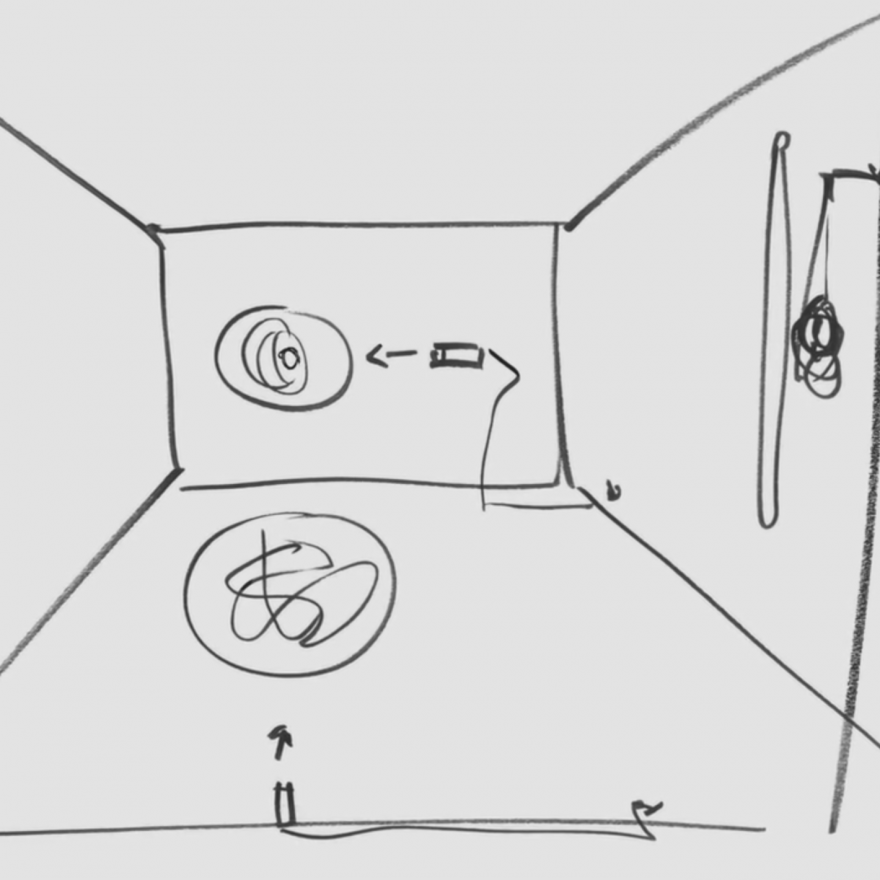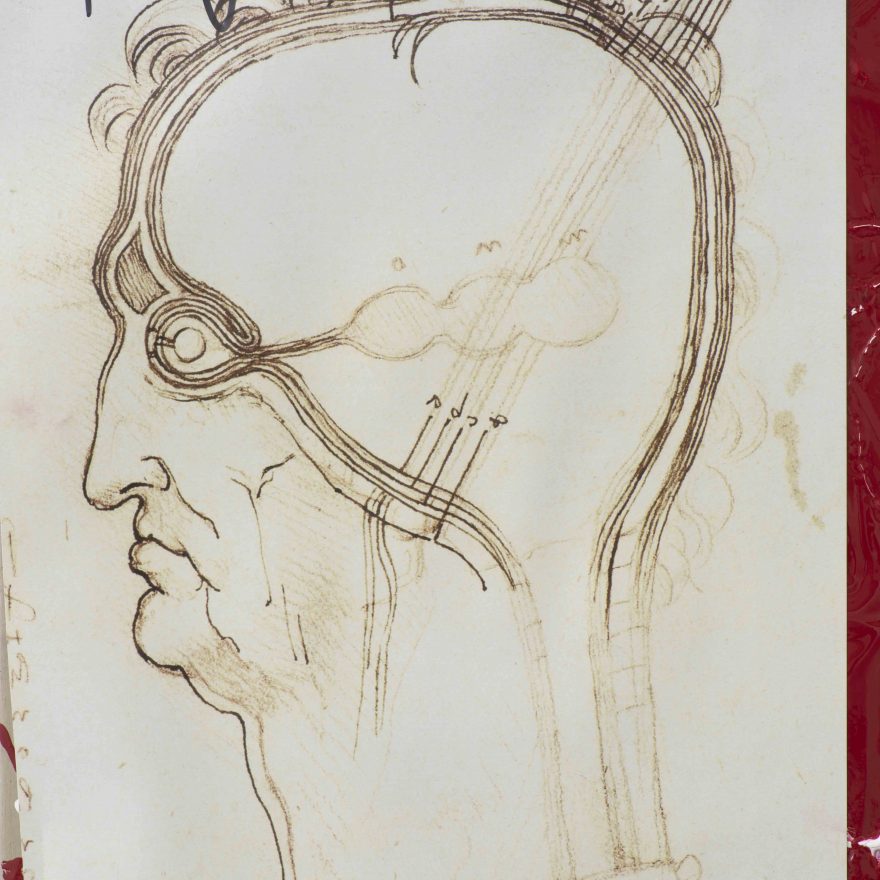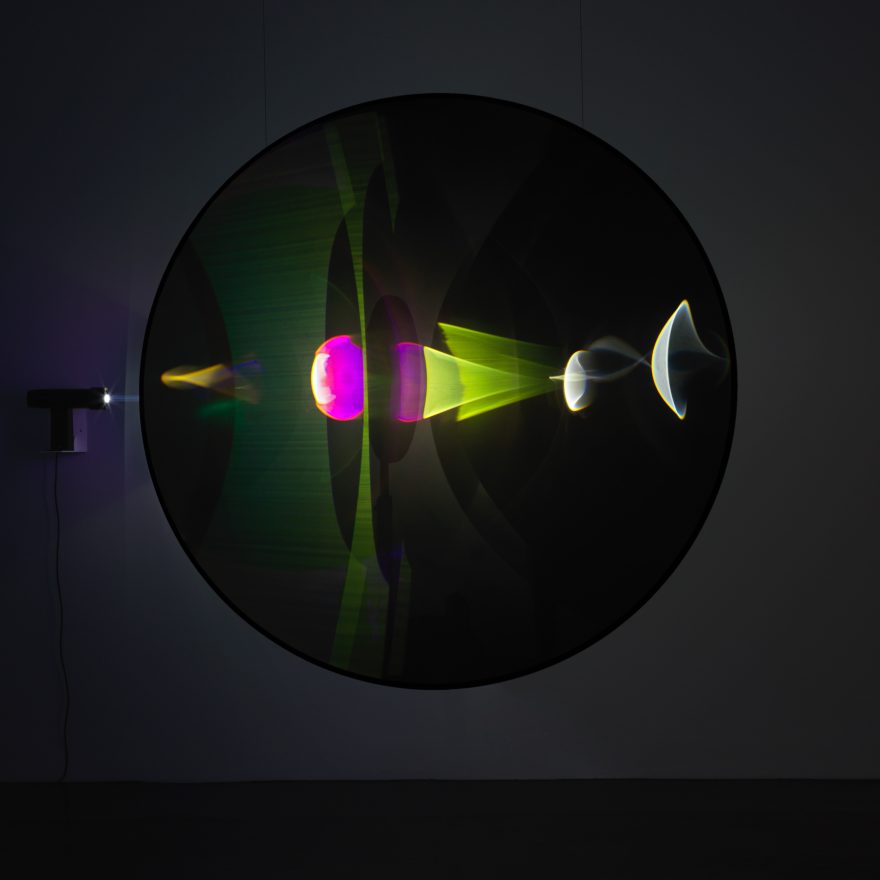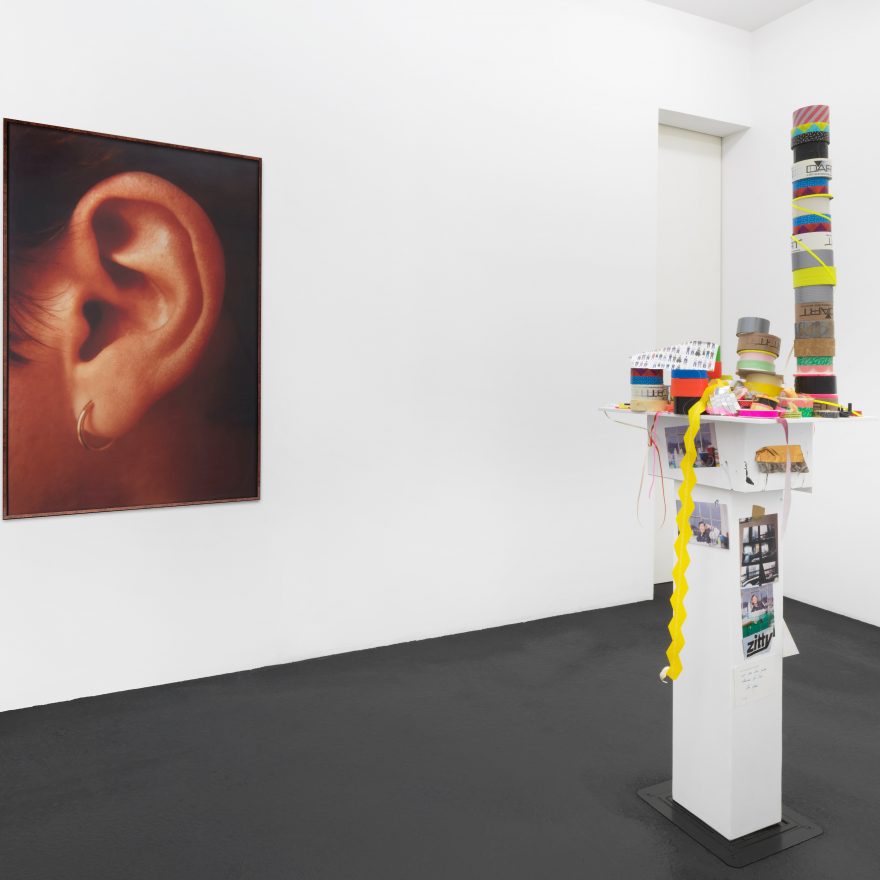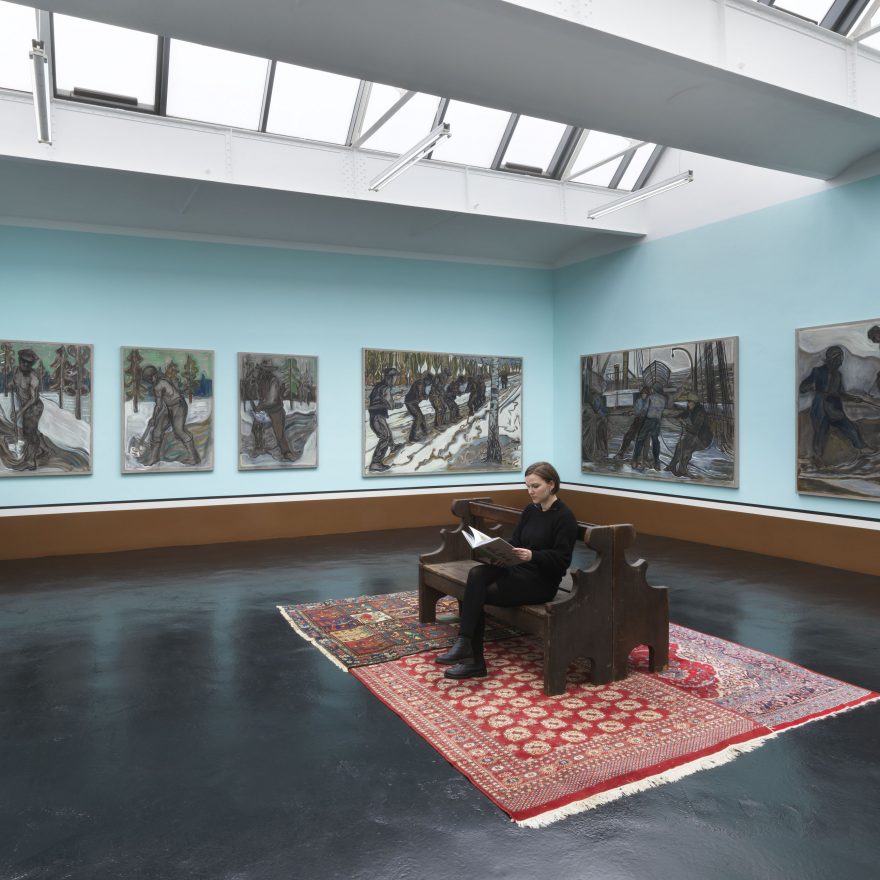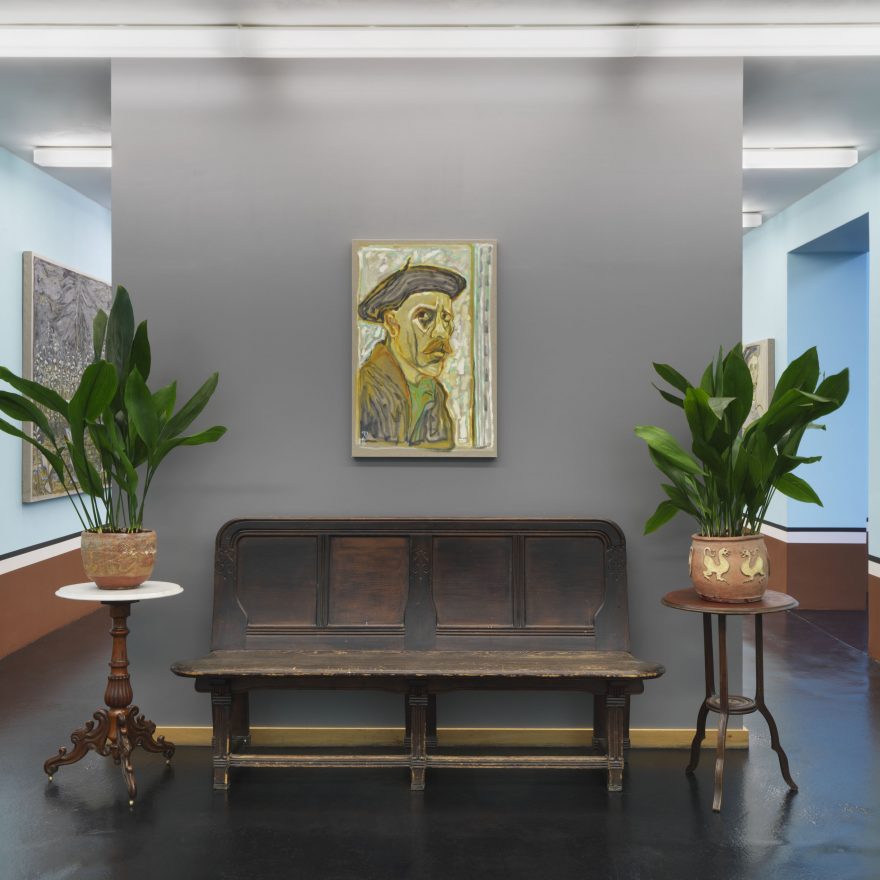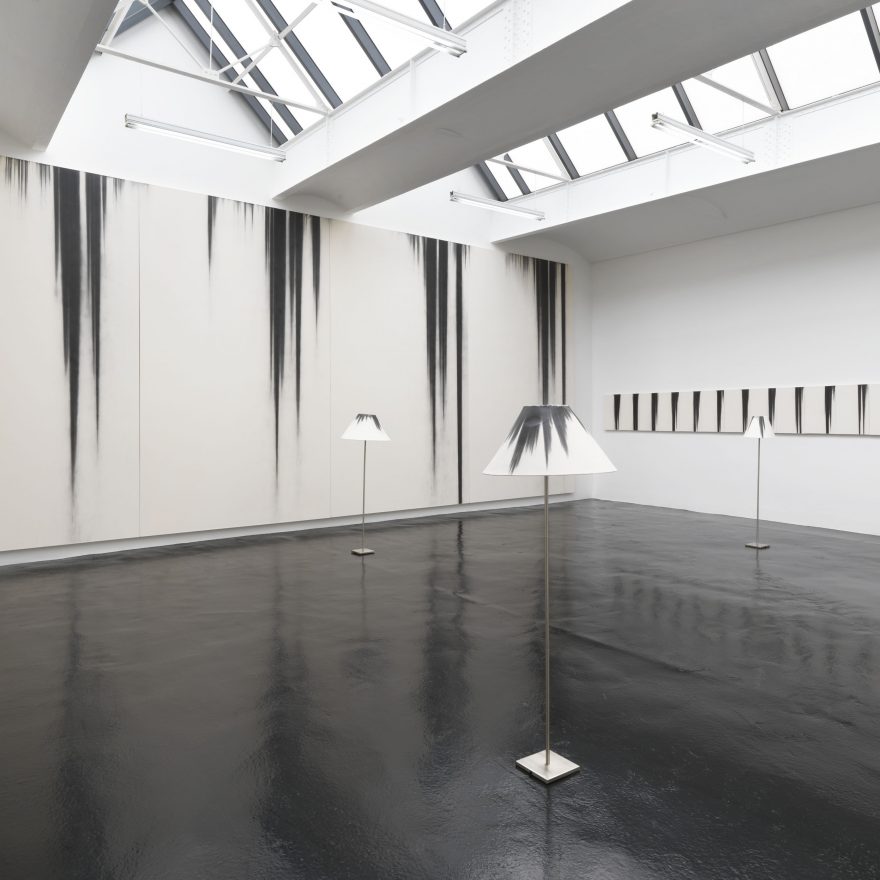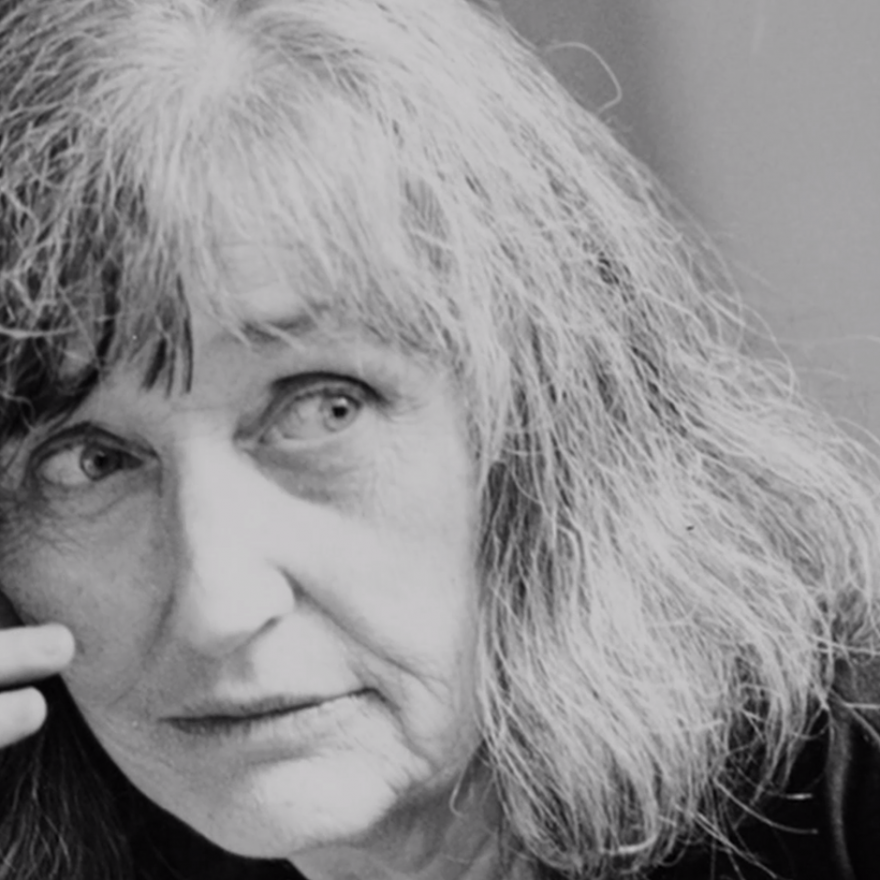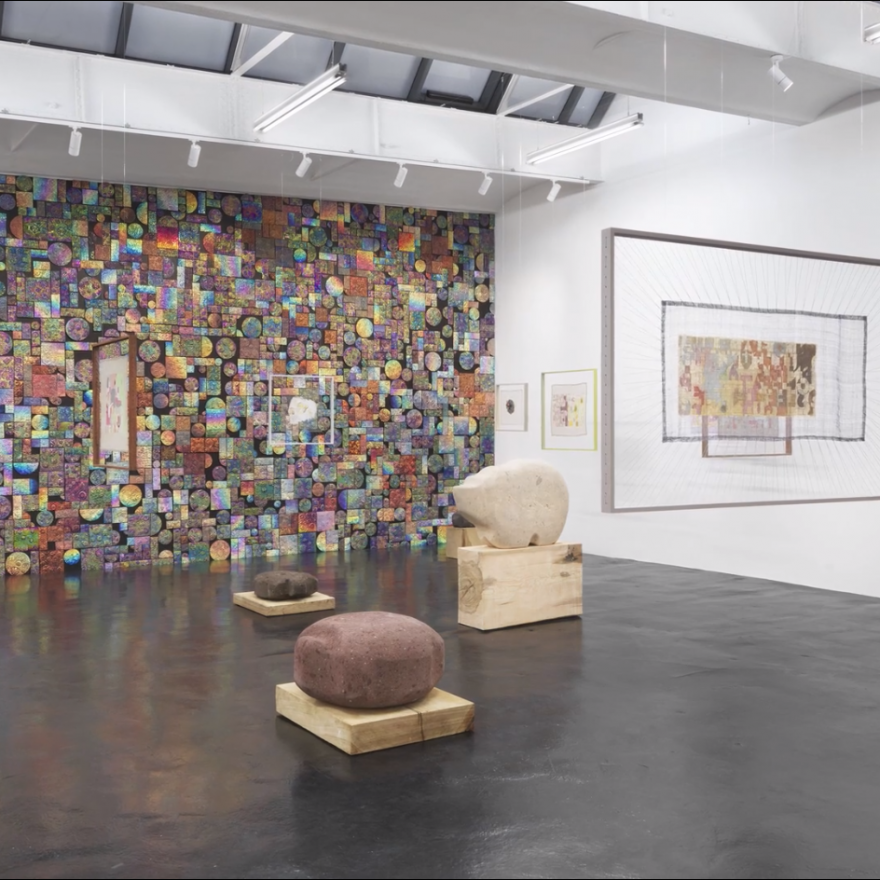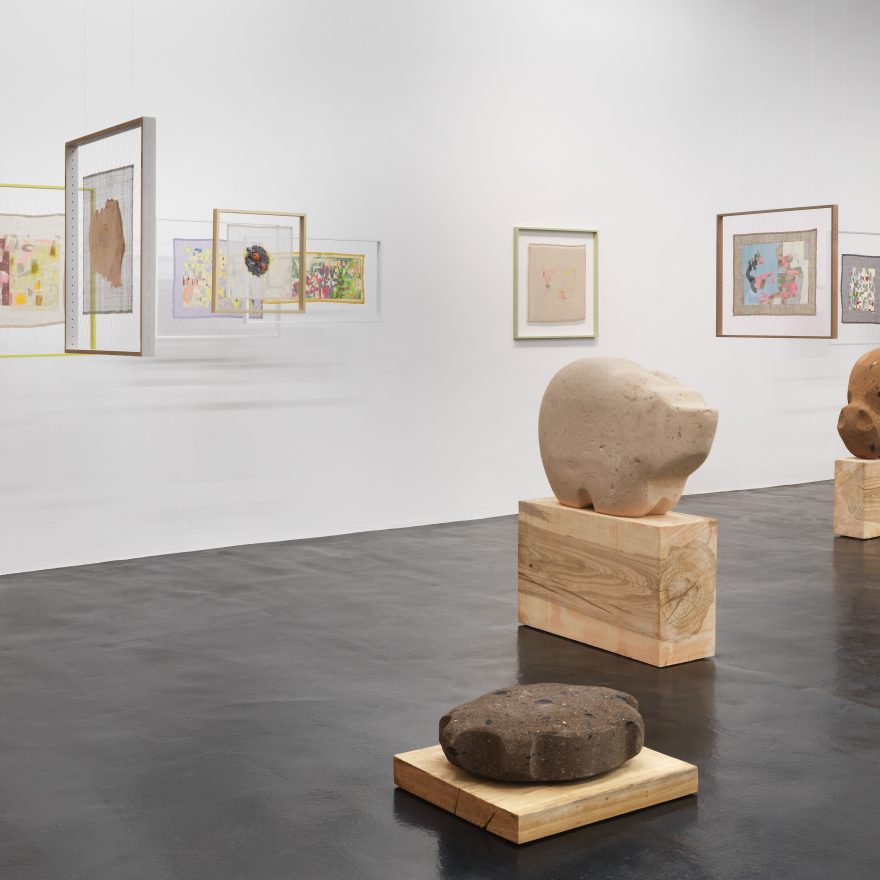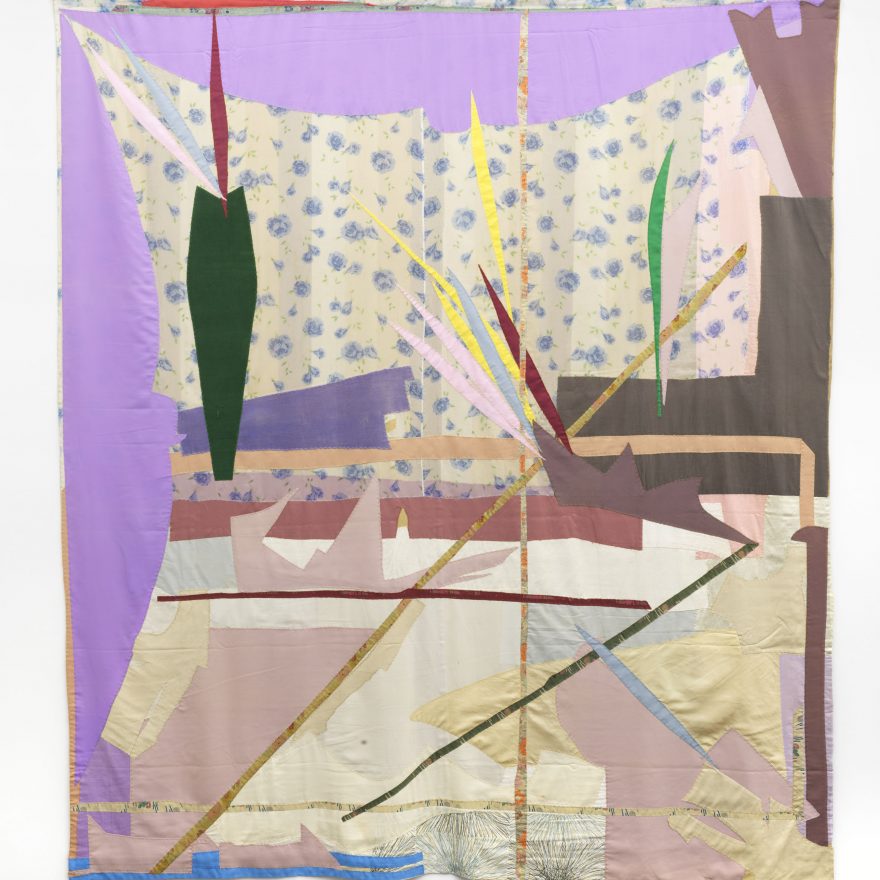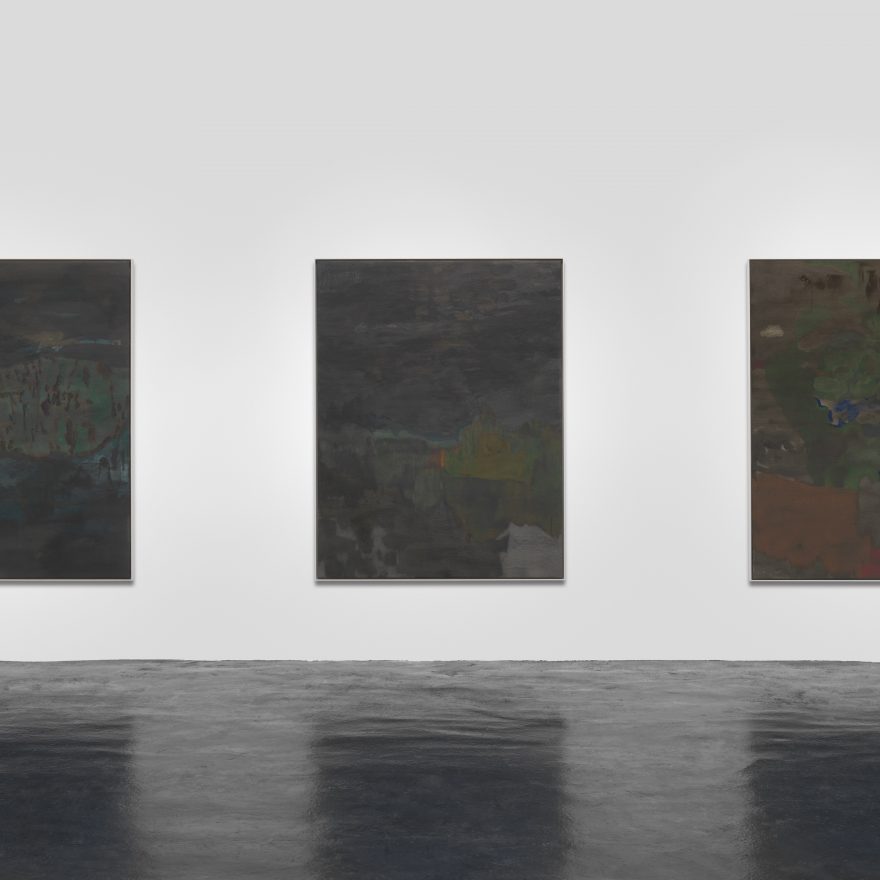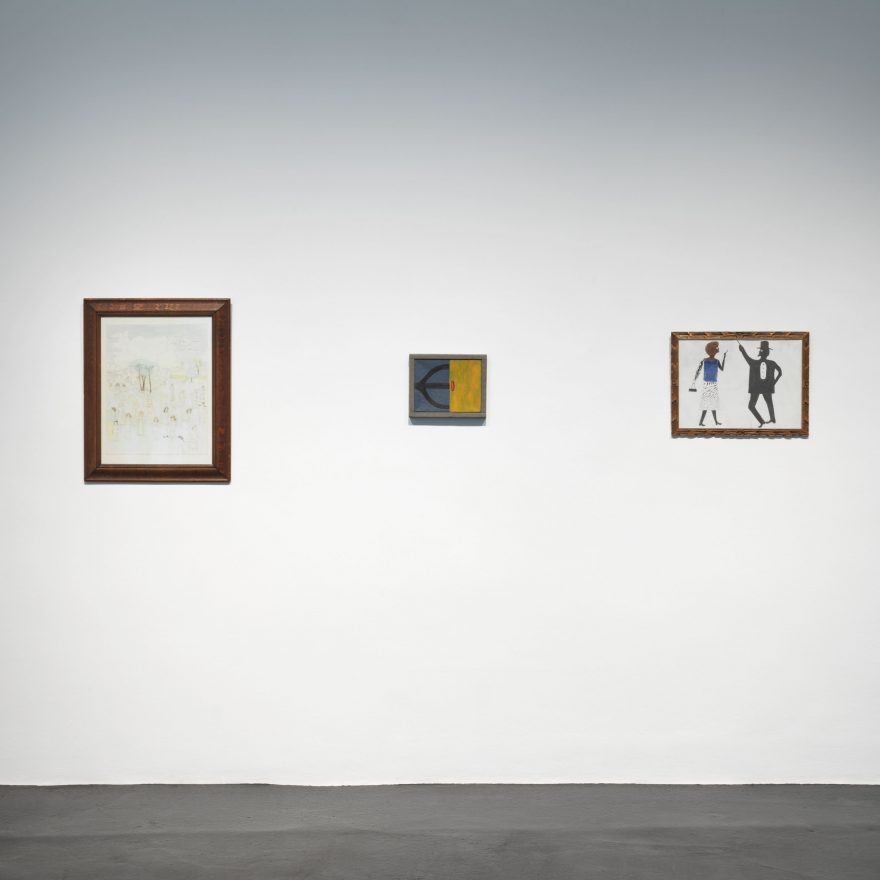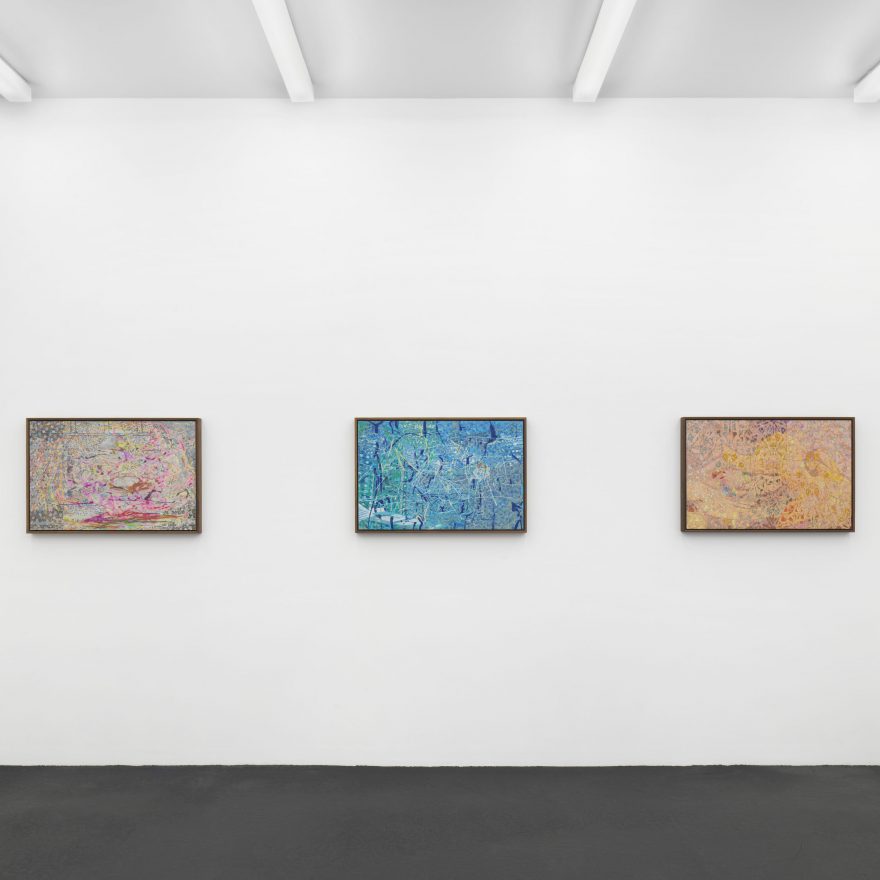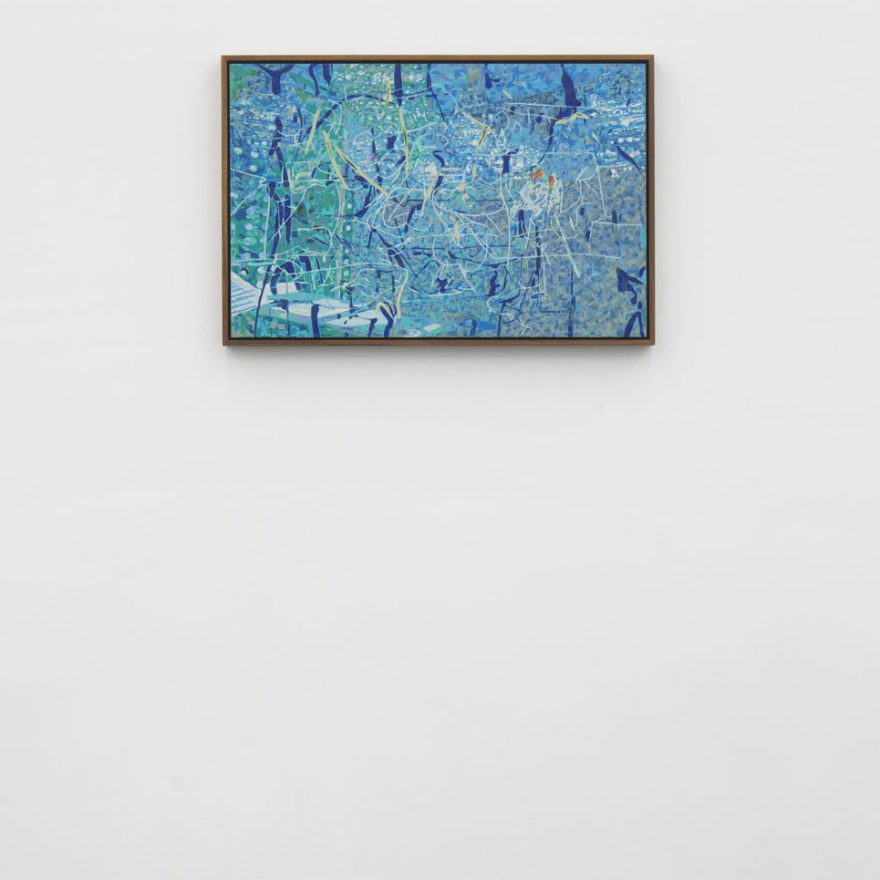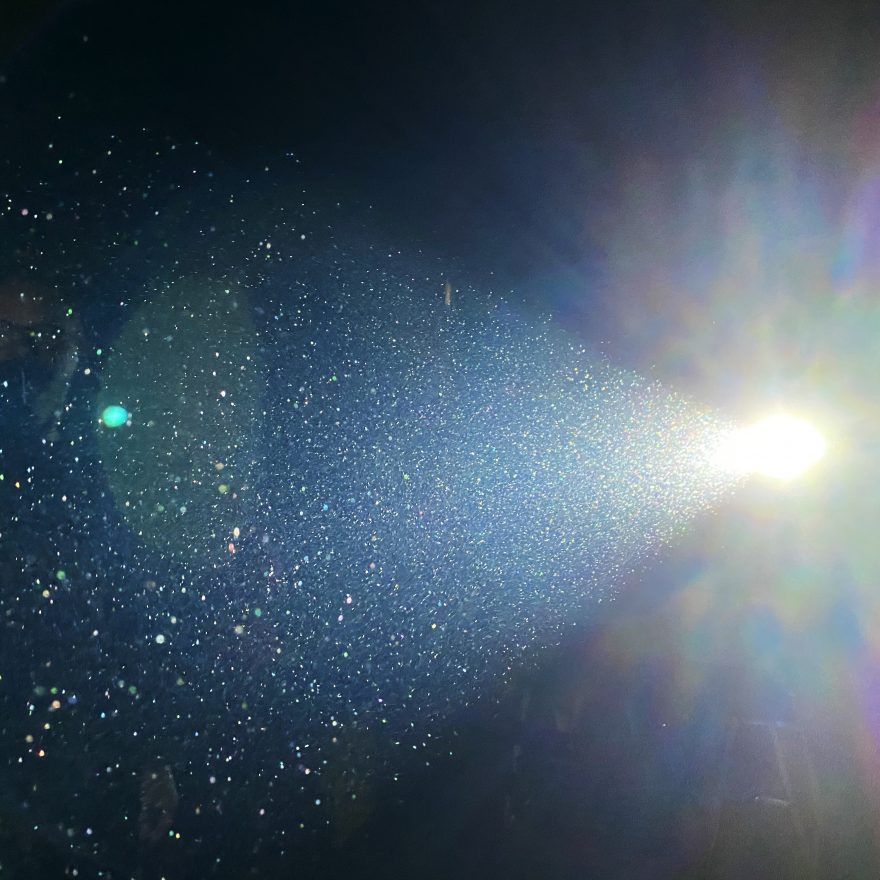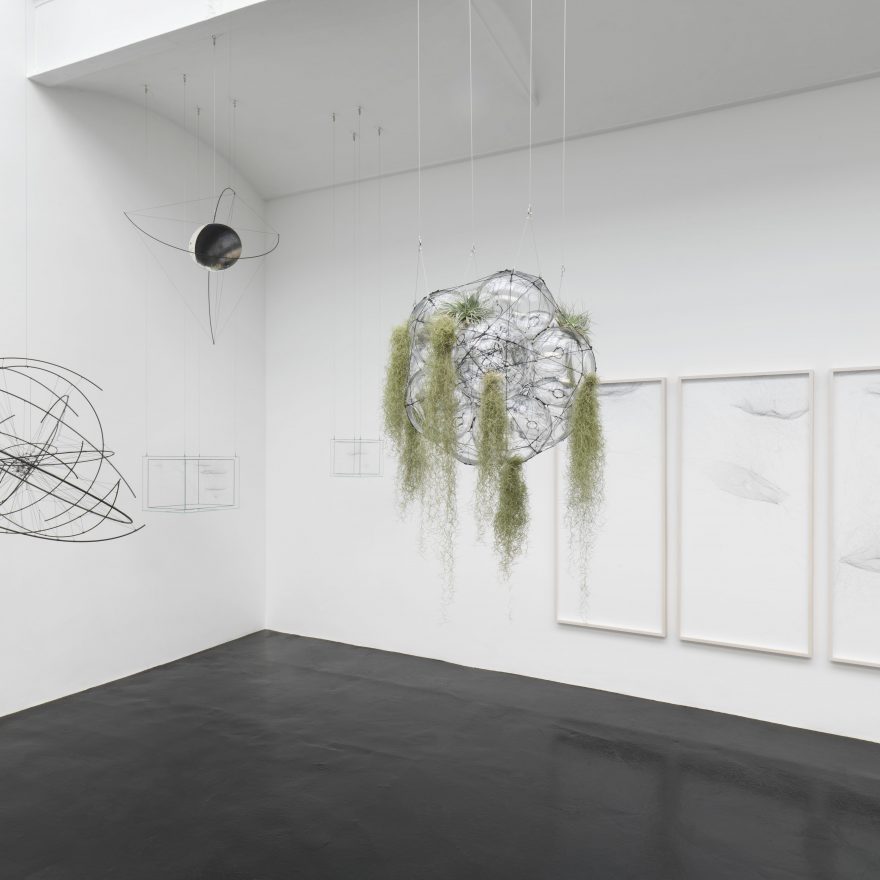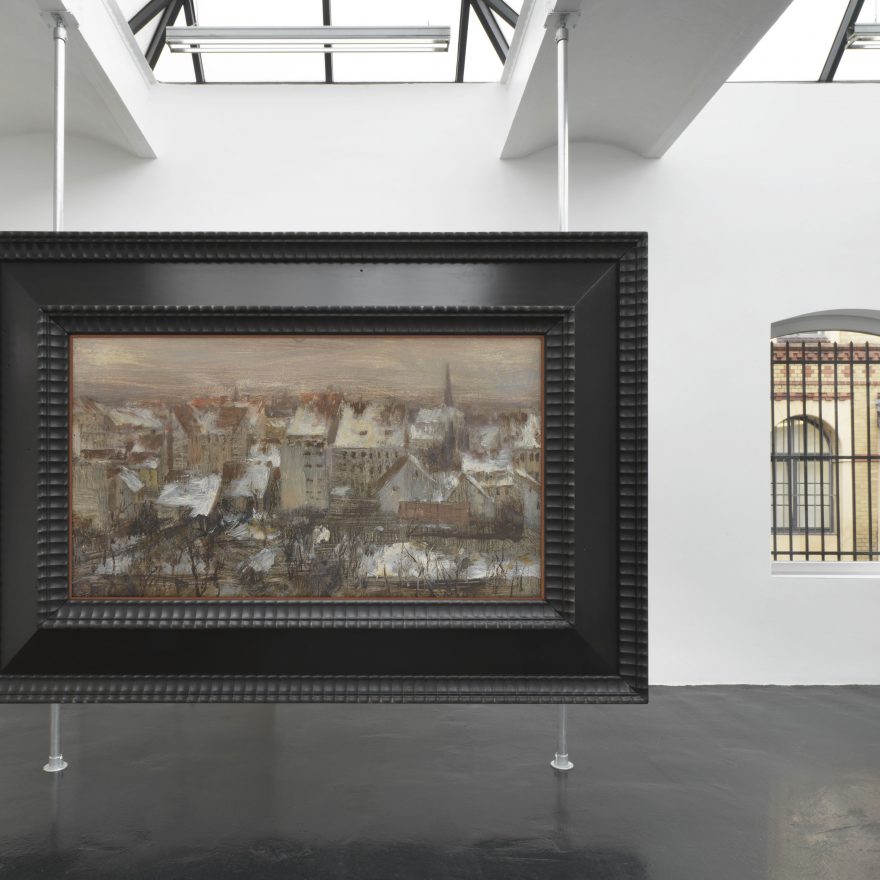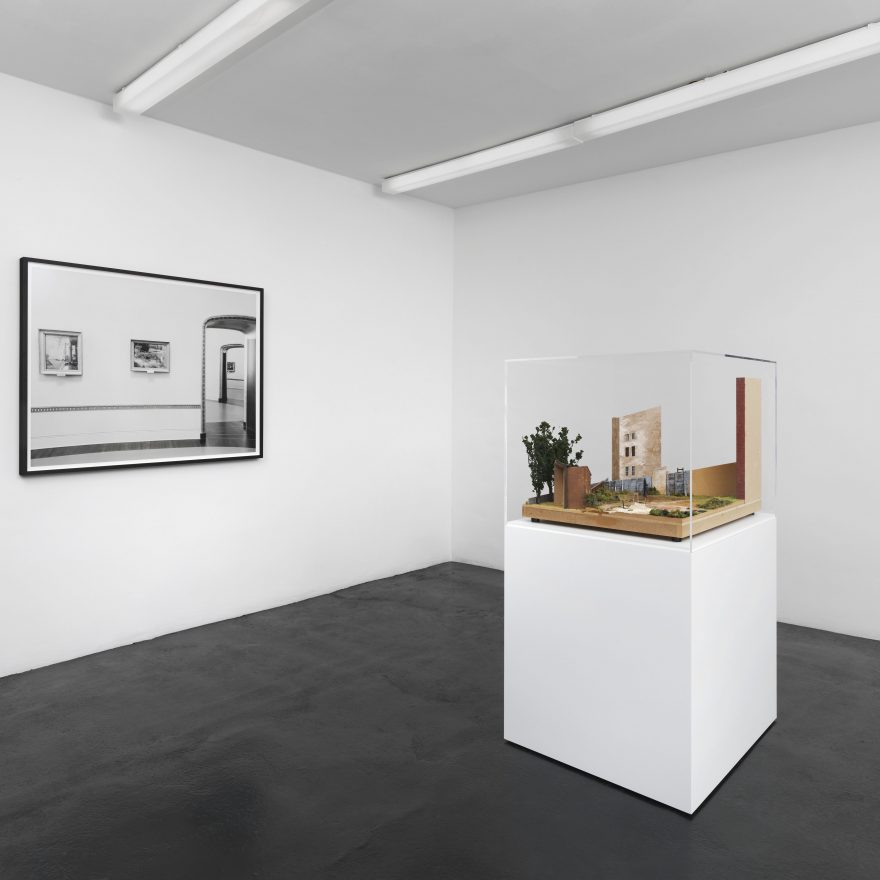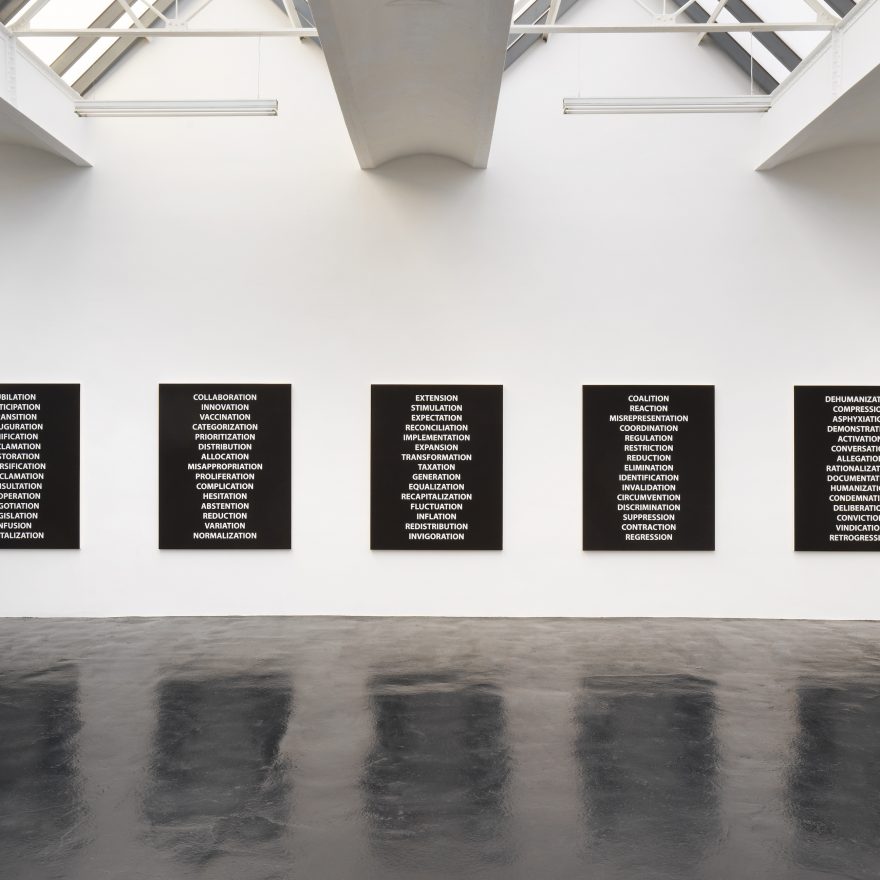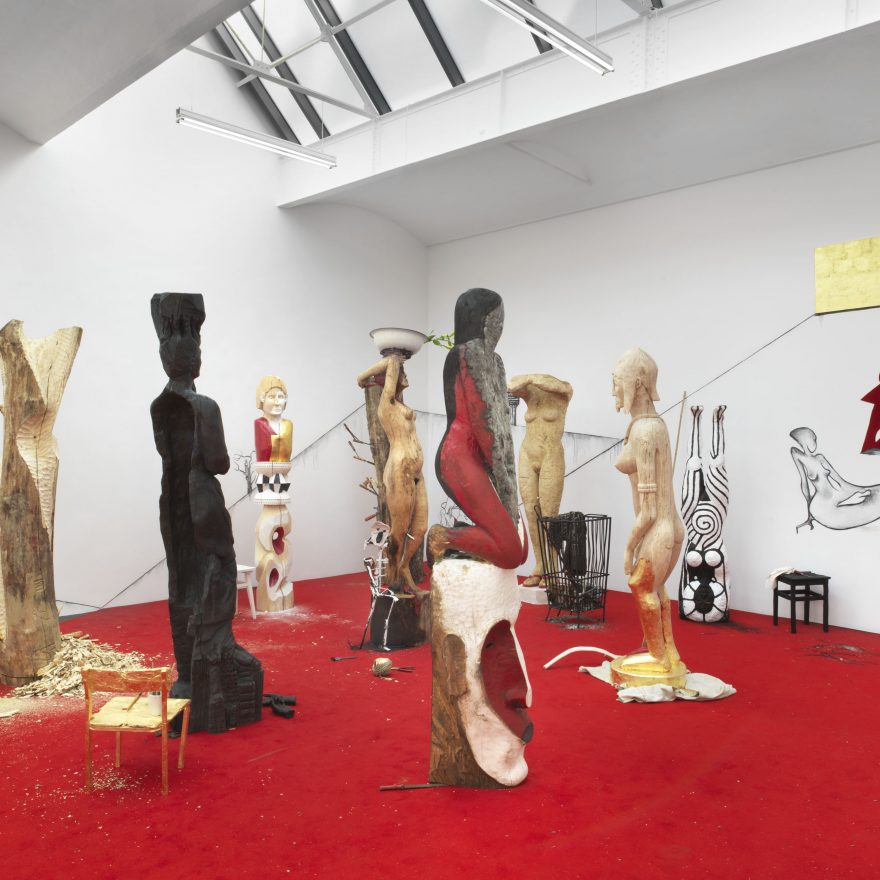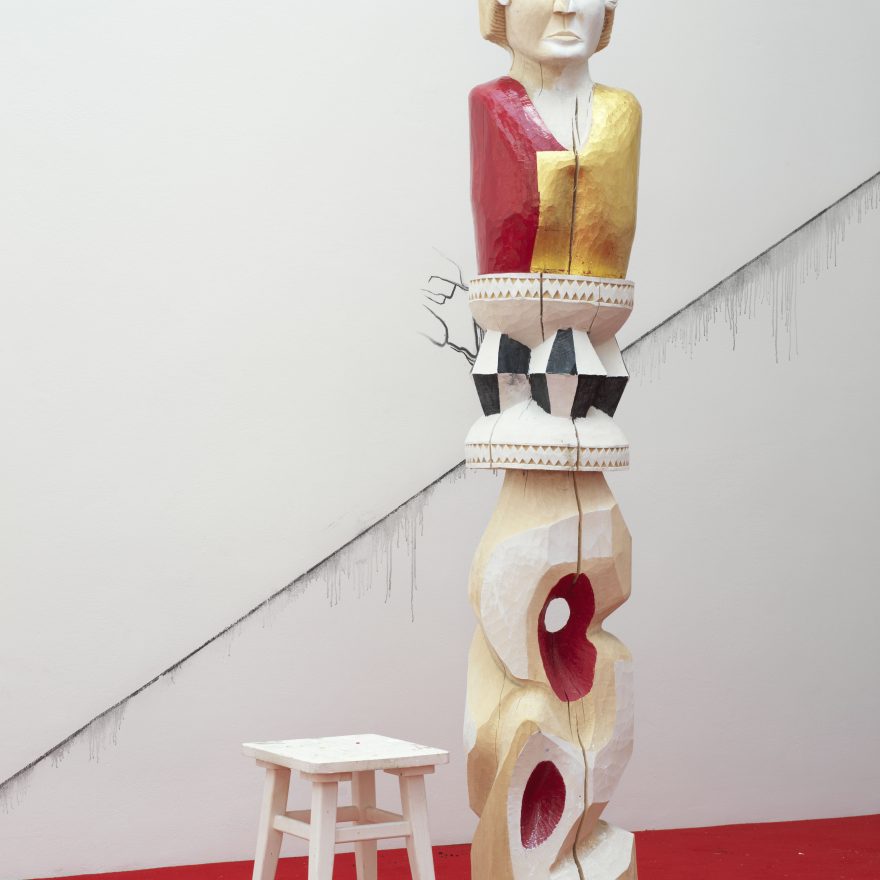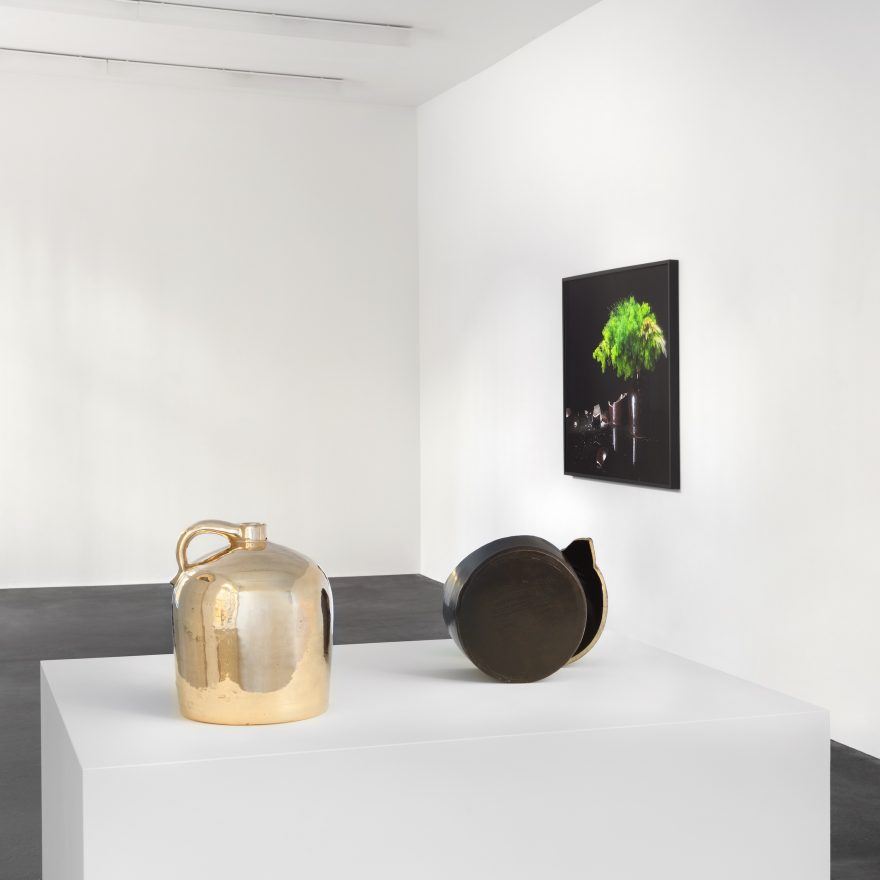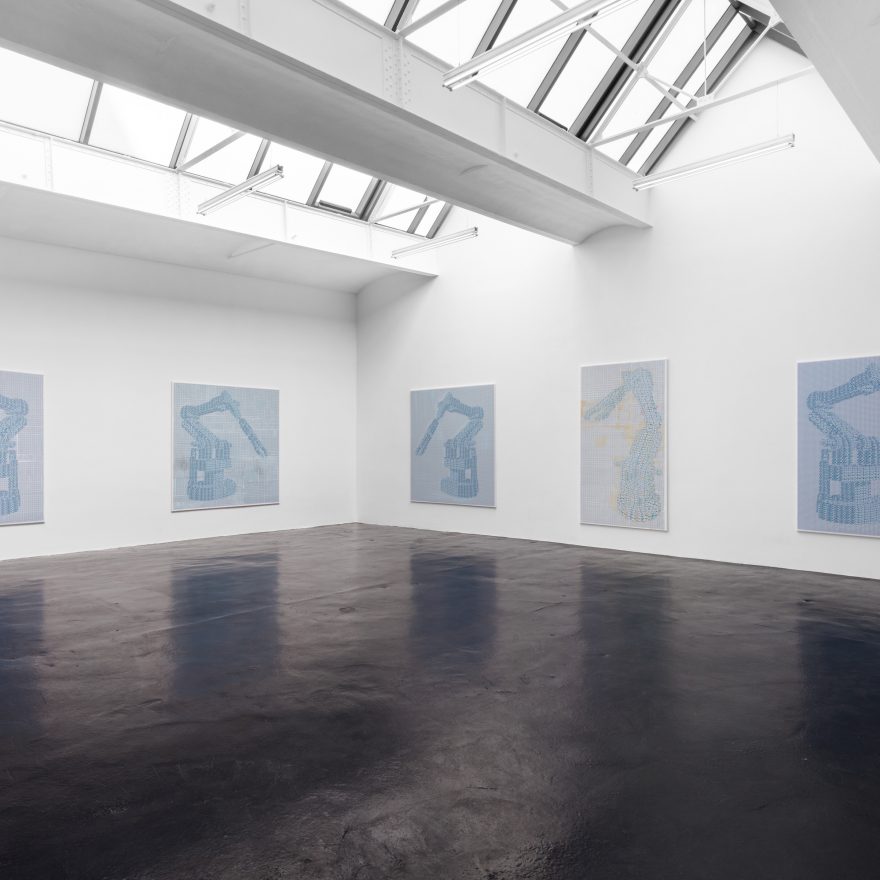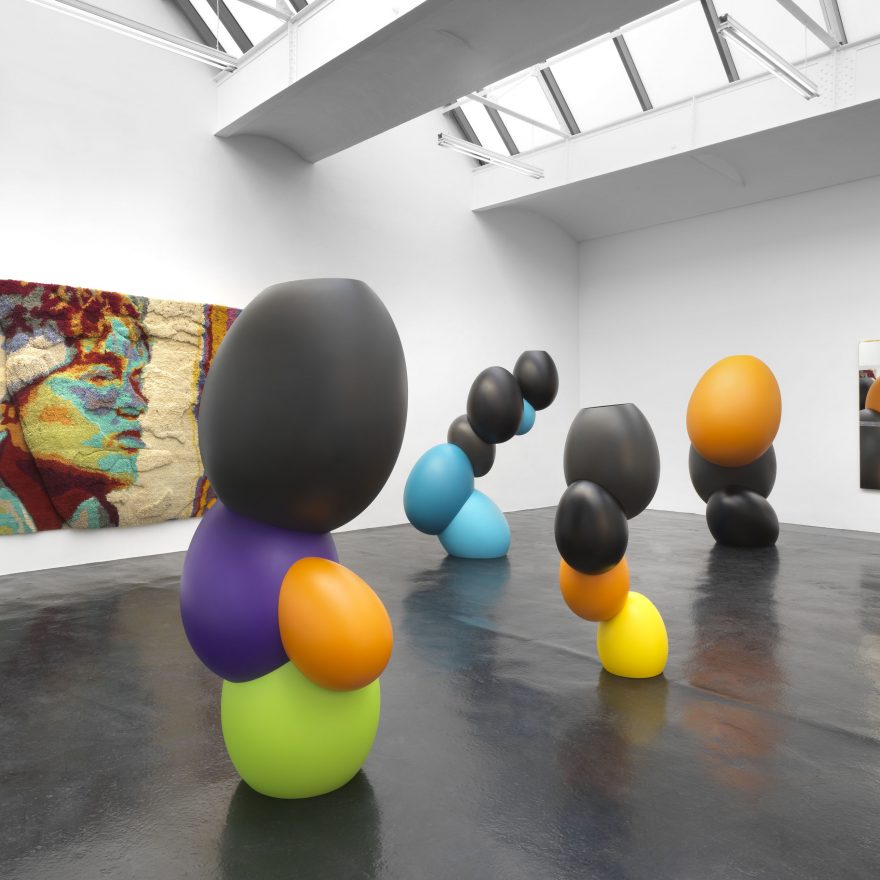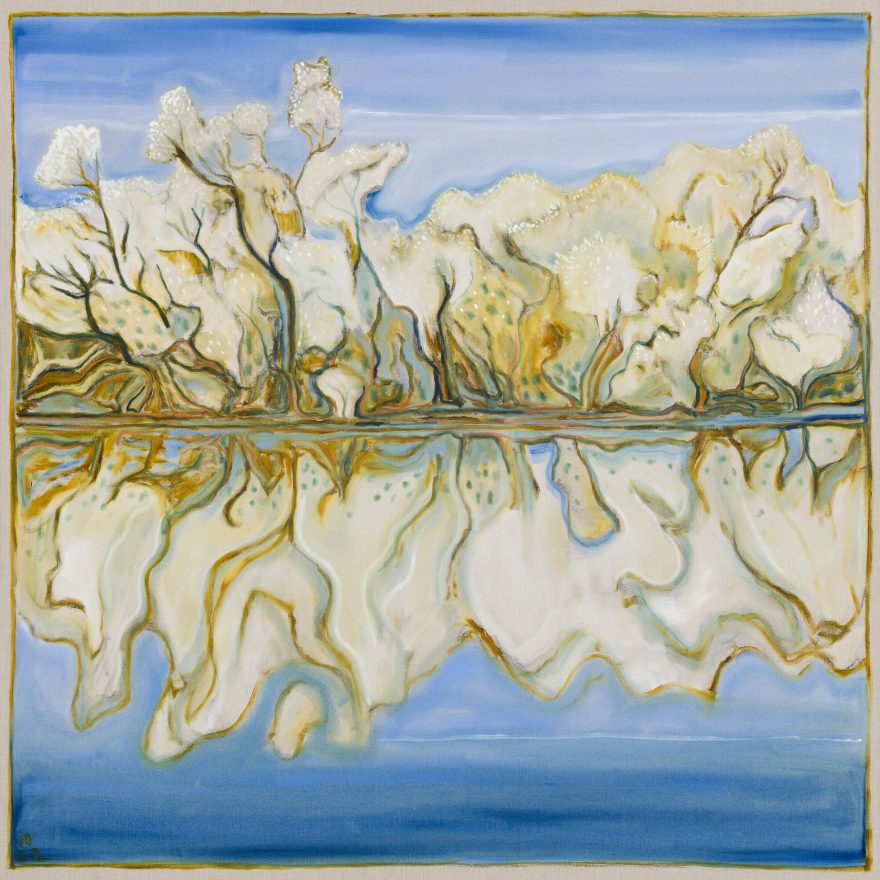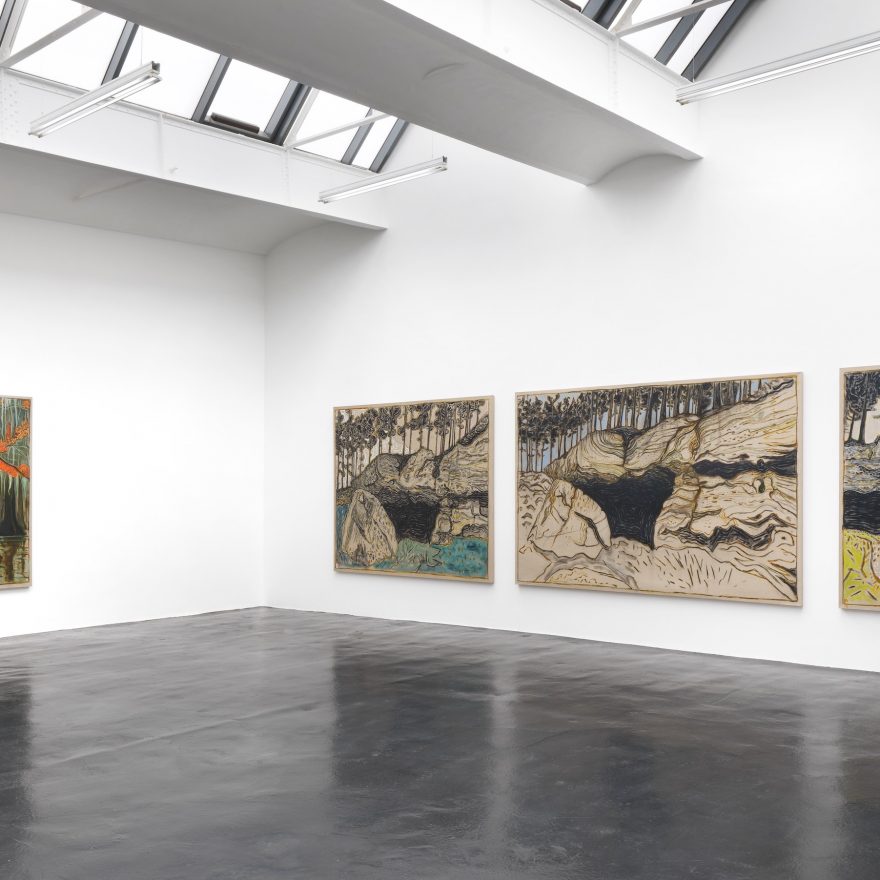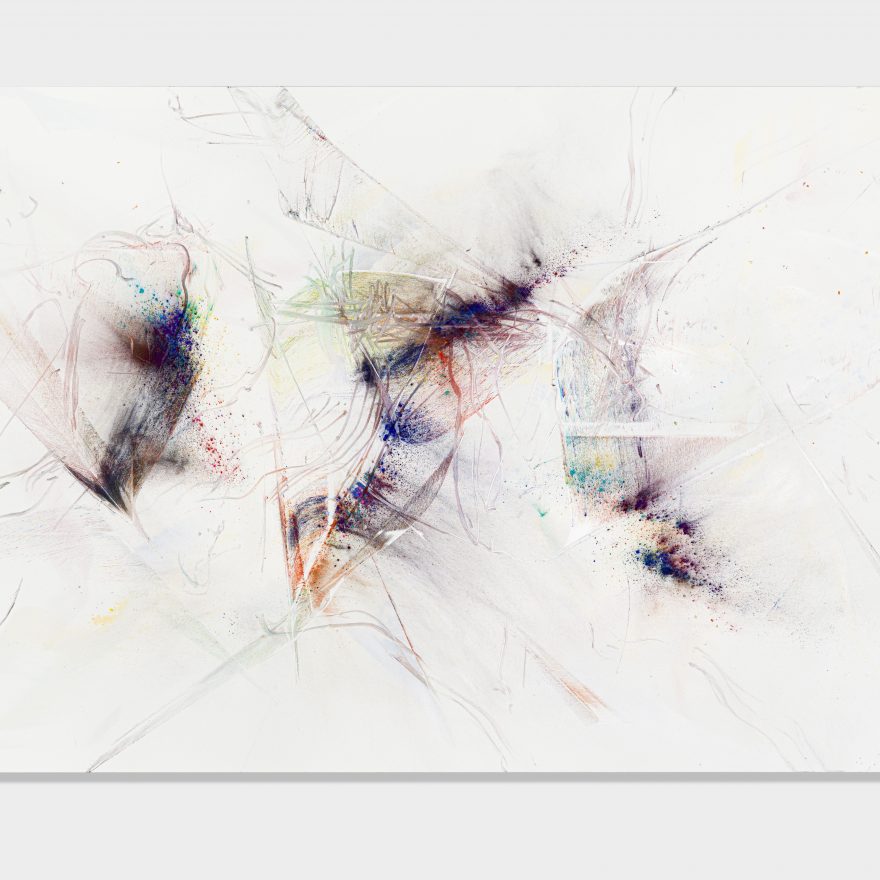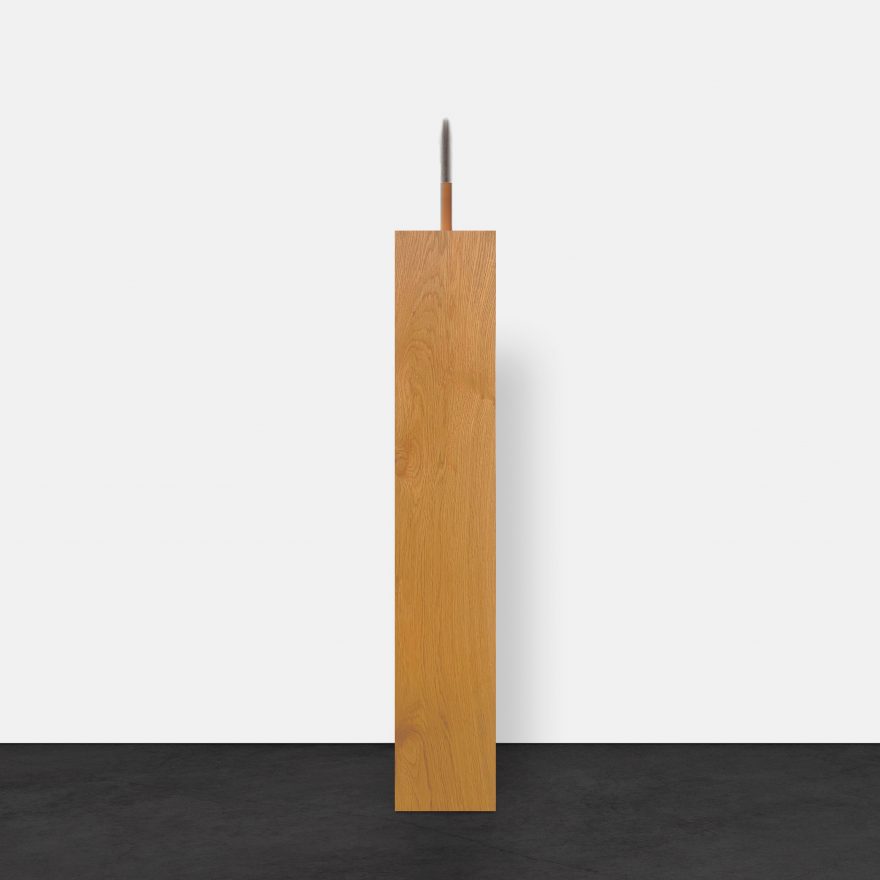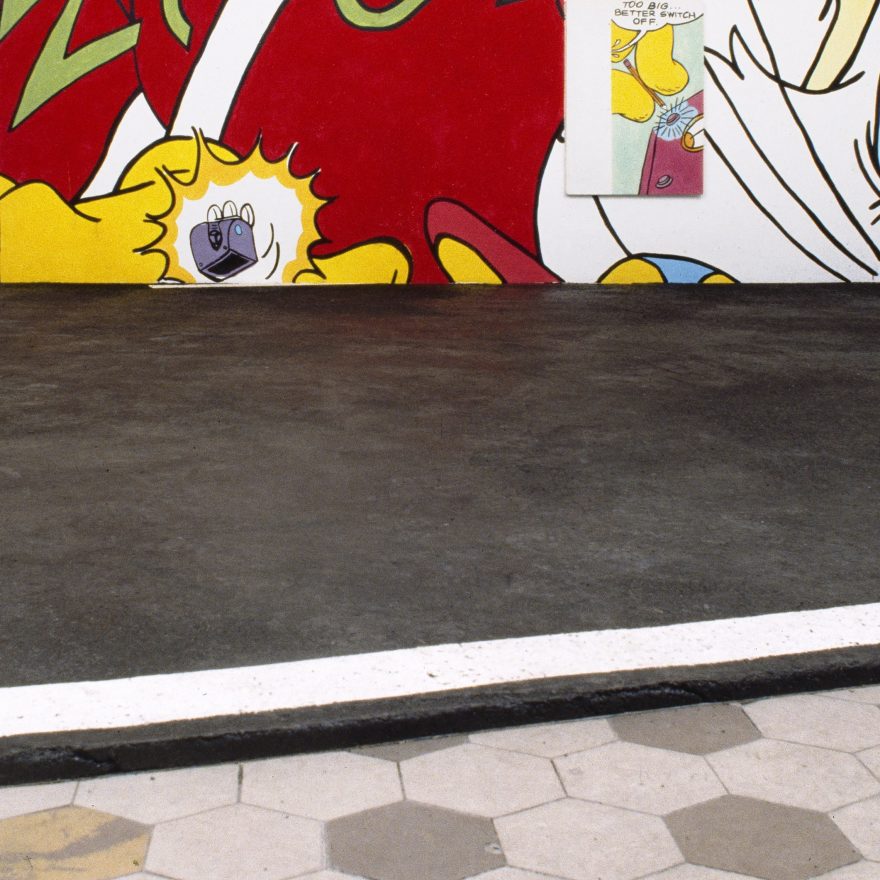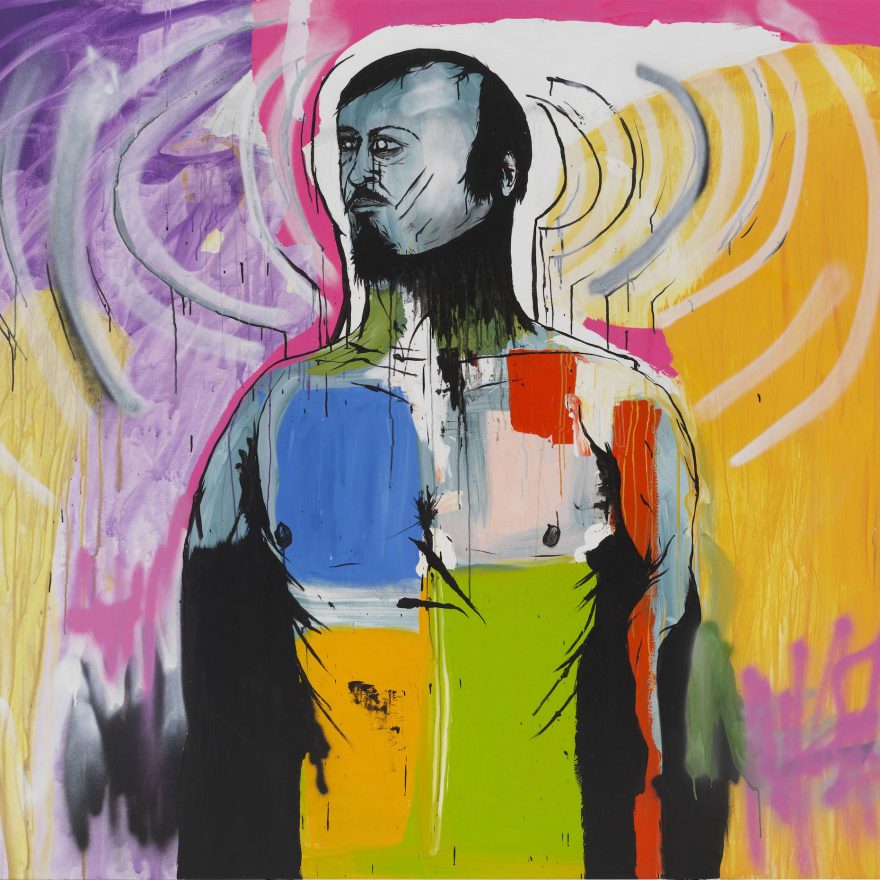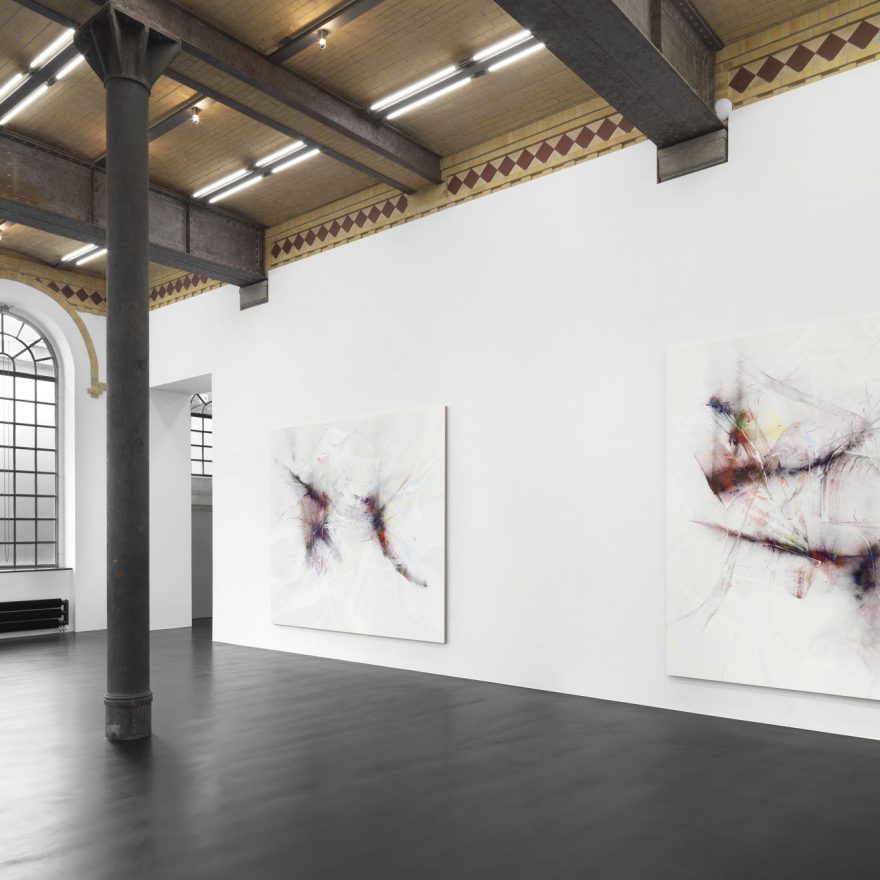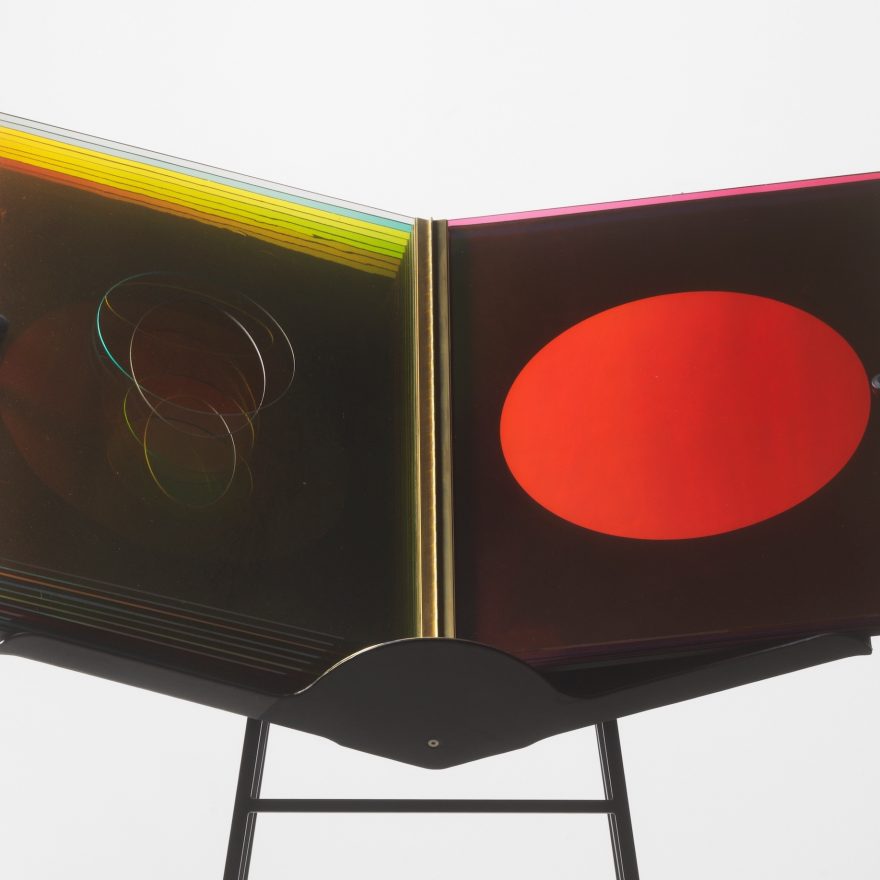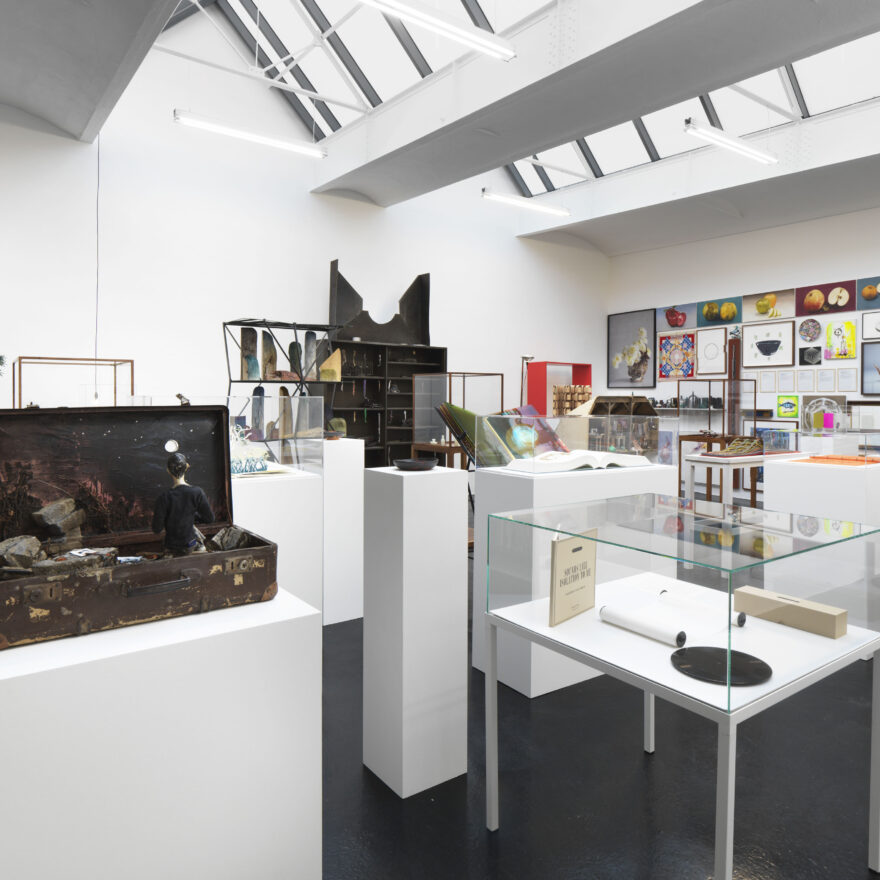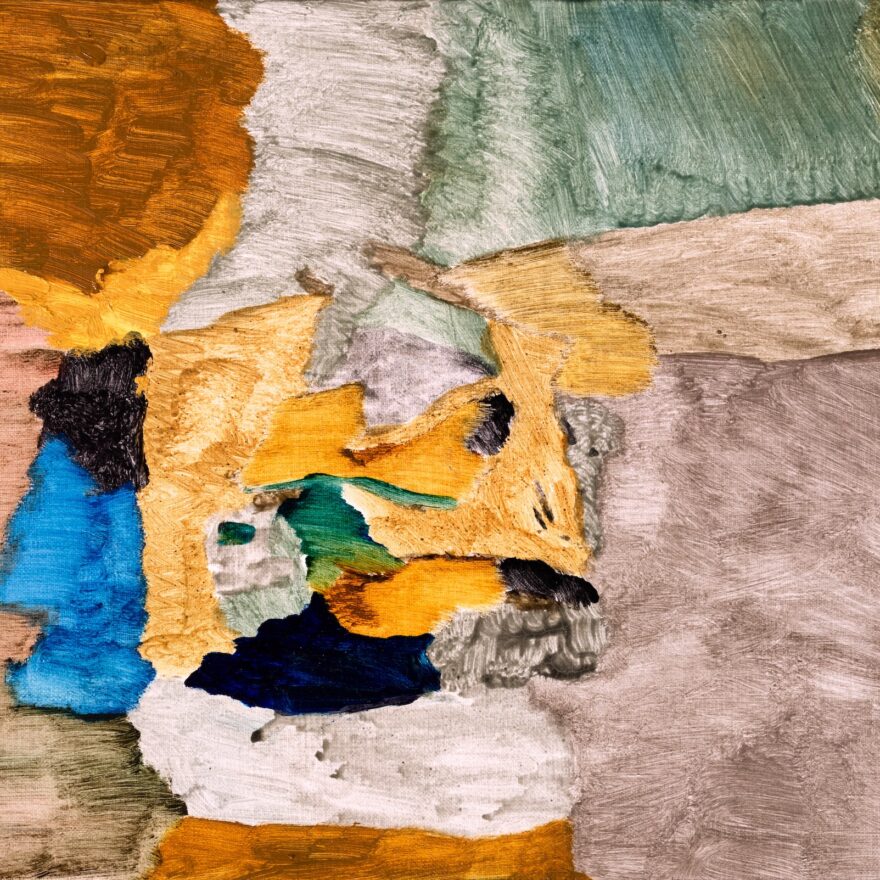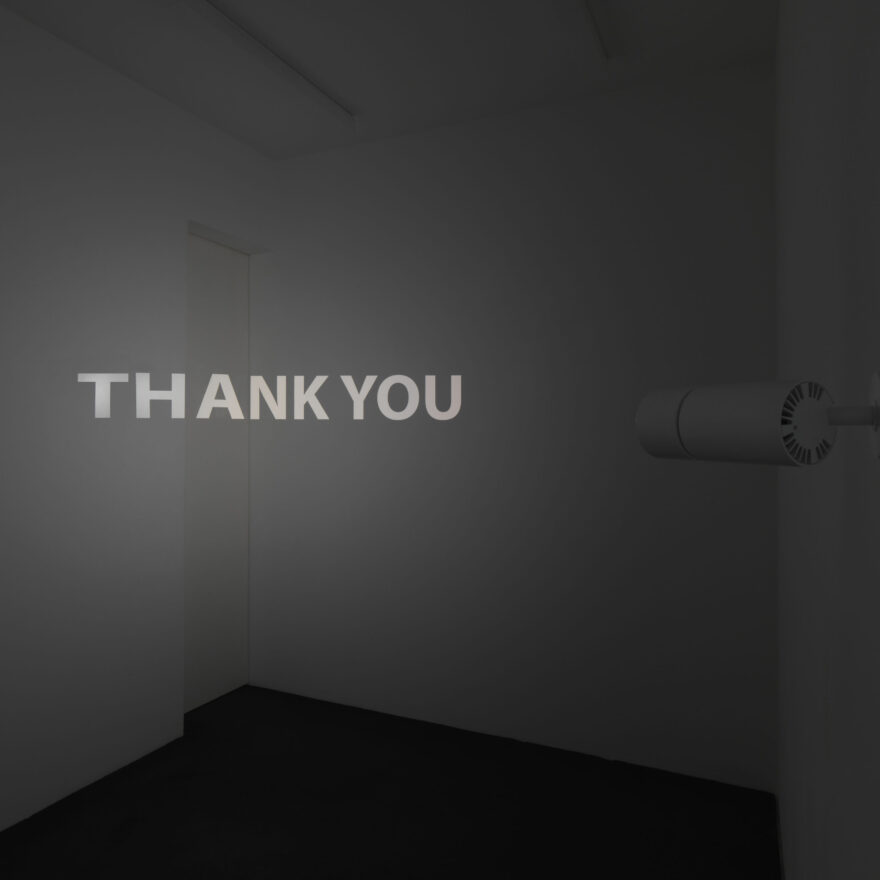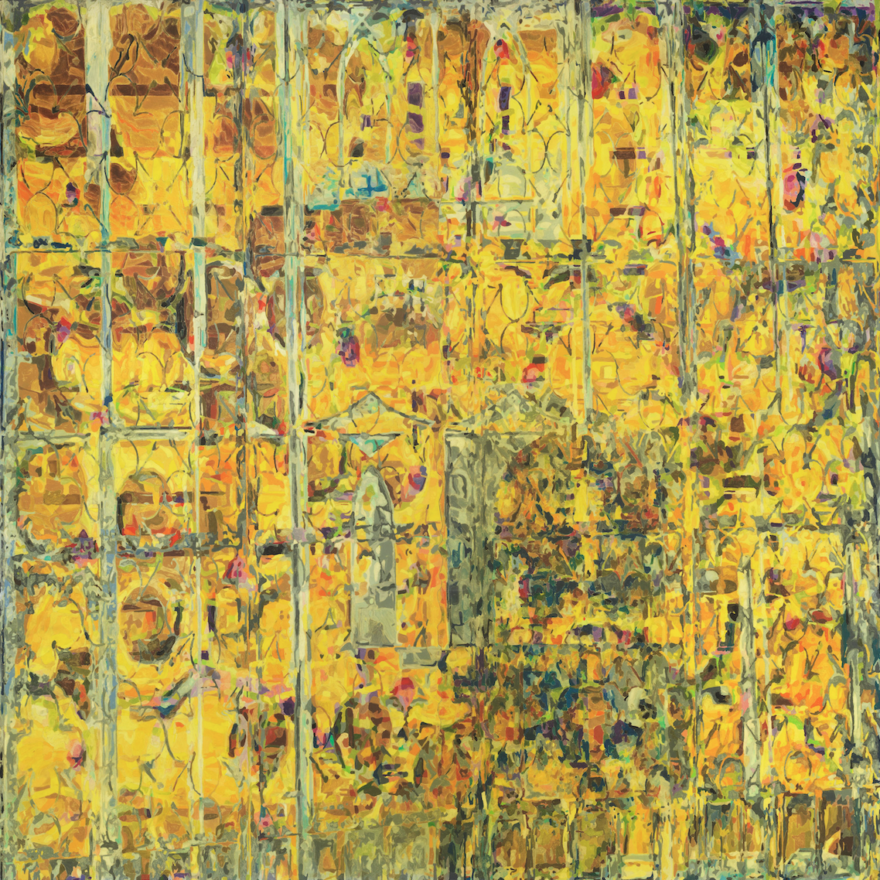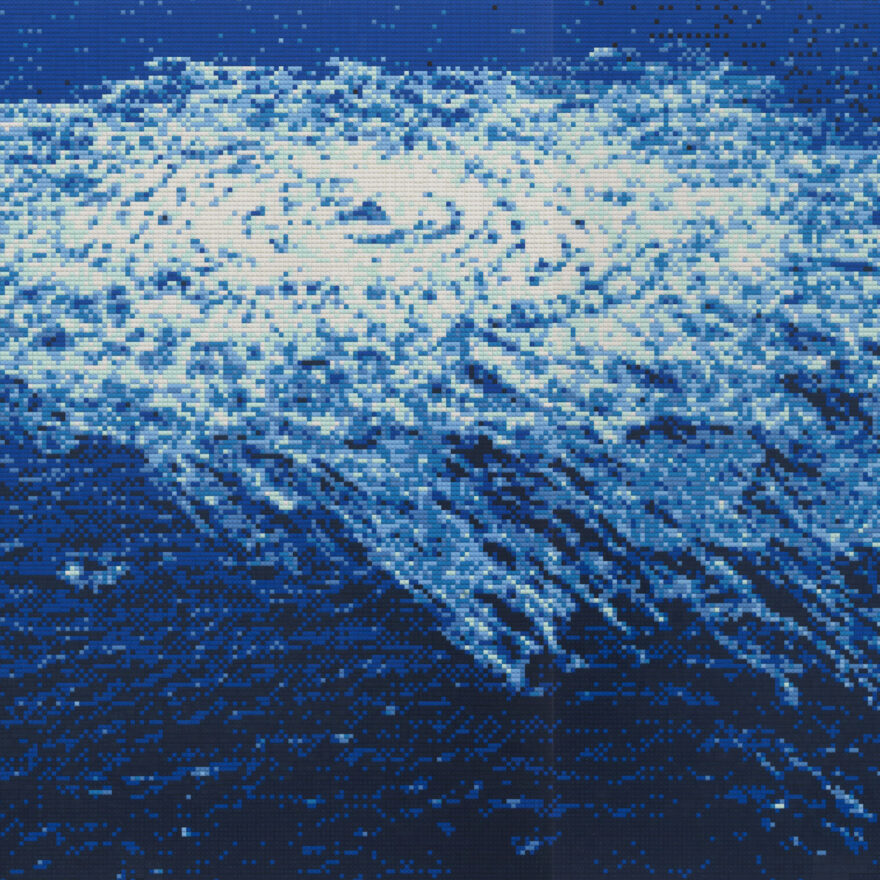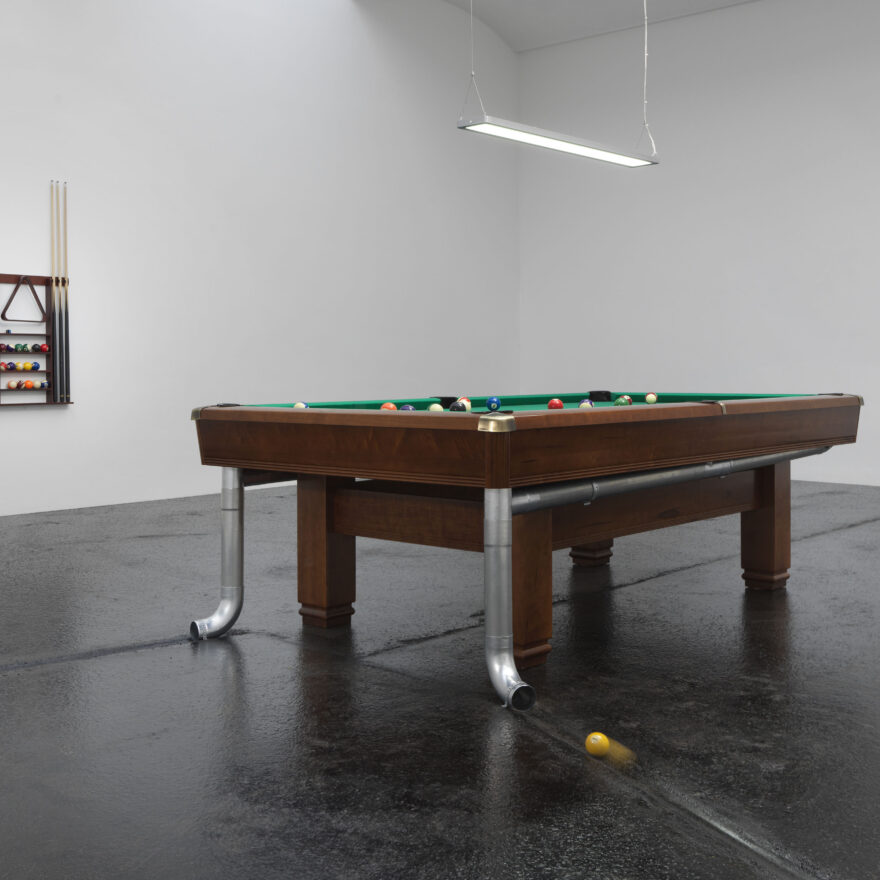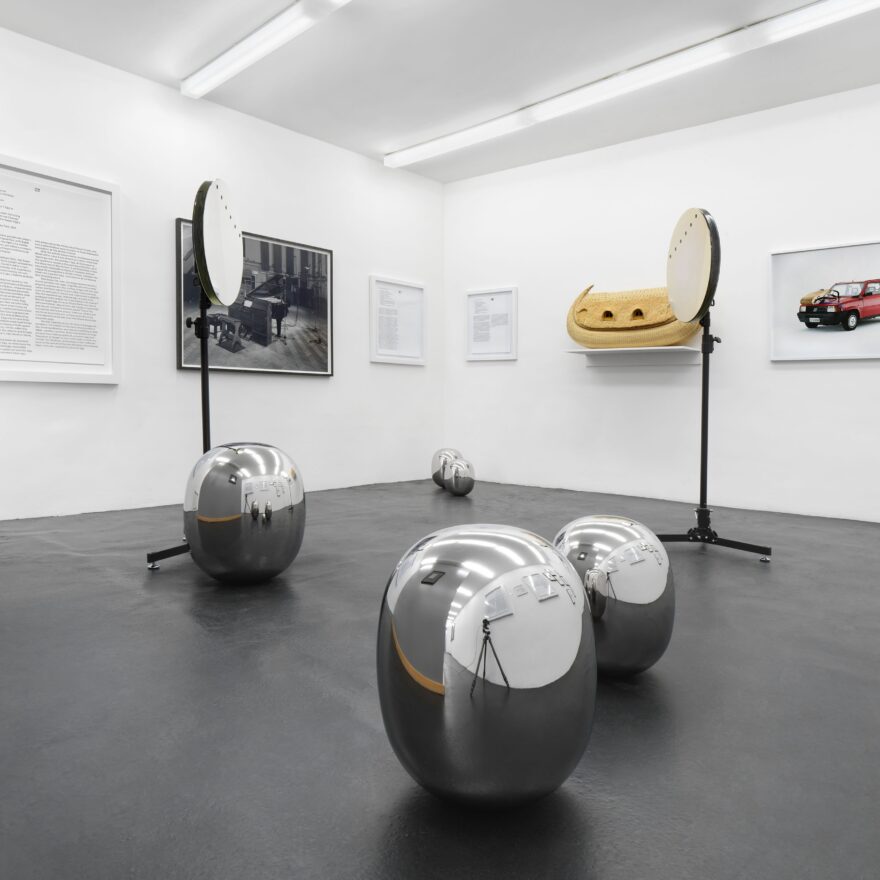Thomas Bayrle
bewegung im stillstand
3 MAY until 28 JUN 2025
Opening – 2 MAY 2025, 6-9 pm
At Linienstrasse 155, 10115 Berlin
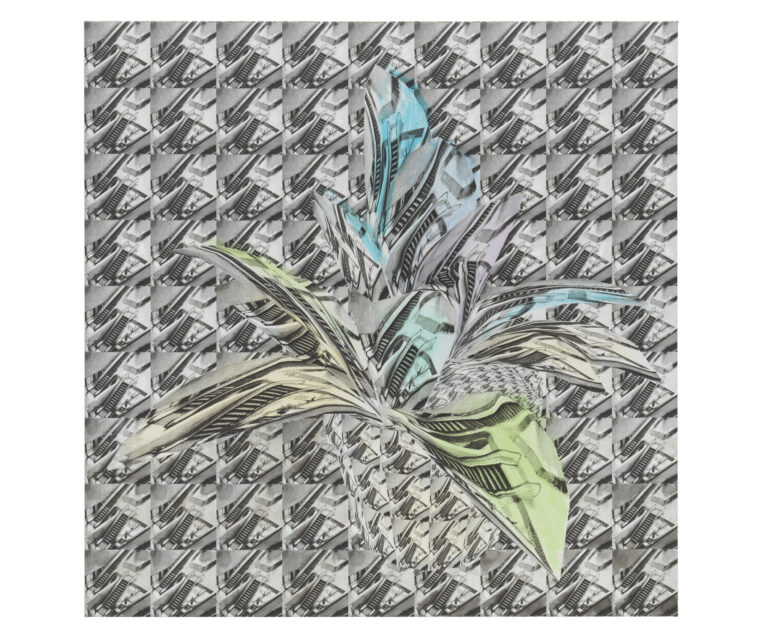
Thomas Bayrle, Pianta Robusta V, 2024
acrylic and FineArt print on linen
90 x 90 cm
© Thomas Bayrle.
Courtesy the artist and neugerriemschneider, Berlin.
Photo: Jens Ziehe, Berlin
Throughout the exhibition, the artist brings into conversation dual fascinations that pervade his practice: modes of conveyance, and consumption of the mass-fabricated products of an industrialized society. Mobility, and the networks that enable it, have long appeared in his body of work as schematic highways, train tracks or conveyor belts, in reflections on the promise of infinite movement. He connotes people and goods in motion, the part rendered anonymous by the whole – contributors to the intricate machinery of the 20th and 21st centuries. Bayrle’s engagement with production in great numbers, and an economy that both feeds and demands it, stems from his first-hand witness of the German economic boom in the wake of the Second World War, his time spent operating an industrial Jacquard loom in the 1950s and his work at an advertising agency in 1960s Frankfurt. From these experiences, Bayrle created an oeuvre that brings to the fore his embrace of the ritual-like repetition inherent in large-scale economic models, utilizing it to conflate and probe the individual, the collective and their nuances.
In Bayrle’s Pianta Robusta I through VIII (all 2024) and Frutta Robusta II (2025), a computer-generated shopping center’s escalators, running in parallel between its floors, repeats to form the works’ backgrounds and their motifs. By turning to the escalator and the indoor mall, Bayrle continues his pictorial investigation of commerce. Occupied only sparsely, the images’ ambiguous subjects exist as both newly constructed, pristine complexes, and once-grand structures pictured as their relevance wanes. The Pianta Robusta works’ squared elements, arranged in nine-by-nine grids, bulge, stretch, twist, magnify, compress and wrap suddenly as the eye progresses toward the surfaces’ centers. A potted plant emerges, its leaves bursting from a structured vessel. Printed in monochromatic greyscale, the works gain gestural touches of hand-applied acrylic paint that thinly coat fragments of the compositions in vibrant blues, greens, yellows and reds. The large-scale Frutta Robusta II shares this foundational scene, configured to a tipped basket and the pumpkins, eggs and corn it once contained, splayed out demonstratively before a viewer. Domesticized indoor plants take shape by way of digitally conceived architectural volumes, assembled to a sterilized city in Citta Pianta (2024), and urban motifs derived from those developed by the artist in the 1970s in Citta Pianta II (2024).
Natural life continues to take center stage in Bayrle’s A Rose is a Rose (1985) – a monumental floral portrait collaged from reduced street maps, shrunk and transformed to densely textured, gradated segments. Stone – Rose (1985) adopts a similar motif, yet is comprised of fragmented photographs taken of A Rose is a Rose, and mounted on cardboard, highlighting the intricately nested, cumulative process from which the artist’s work frequently results. In Bayrle’s Gummibaum (1993 – 1994), this method is set into motion as successive stills depicting a crowd crossing a patch of pavement, printed on sheets of latex, are painstakingly sequenced to an eight-minute film. First shown in their flattened, unmanipulated states, the frames are manually maneuvered to become a plant’s stem and leaves viewed as they rotate. Bayrle here summarizes the ethos that characterizes bewegung im stillstand, in which a world harnessed, contained or controlled, and the human-made apparatus of contemporary existence that populate it, are brought to coexist, the organic and the constructed partaking in symbiotic exchange.
Thomas Bayrle (b. 1937) is the subject of comprehensive retrospectives at SCHIRN KUNSTHALLE FRANKFURT, Frankfurt am Main and Museum im Kulturspeicher, Würzburg in February 2026. He has previously been the subject of solo exhibitions at international museums and institutions including Pinacoteca Agnelli, Turin (2023); New Museum, New York (2018); MAK – Museum of Applied Arts, Vienna (2017); Institute of Contemporary Art, Miami (2016); Lenbachhaus, Munich (2016); Institut d’art contemporain, Villeurbanne/Rhône-Alpes (2014); WIELS Centre for Contemporary Art, Brussels (2013); Madre – museo d’arte contemporanea Donnaregina, Naples (2013); Baltic Centre for Contemporary Art, Gateshead (2013); Museu d’Art Contemporani de Barcelona, Barcelona (2009); Musée d’art moderne et contemporain, Geneva (2009); Museum Ludwig, Cologne (2008); and Museum für Moderne Kunst, Frankfurt am Main (2006). His work has been shown at leading group exhibitions including three editions of documenta (3, 6, and 13) in Kassel (1964, 1977, 2012), the 8th Busan Biennale (2012), the 16th Biennale of Sydney (2008), the 9th Biennale d’art contemporain de Lyon (2007), the 4th Berlin Biennale for Contemporary Art (2006), the 6th and 8th Gwangju Biennale (2006, 2010), the 2nd and 6th Guangzhou Triennial (2005, 2018) and the 50th and 53rd Venice Biennale (2003, 2009). Bayrle has been the recipient of several awards and prizes, including the Arnold-Bode-Preis (2012), the Cologne Fine Art Prize (2000) and the Prix Ars Electronica (1995). Bayrle lives and works in Frankfurt am Main.
For further press information and imagery, please contact Jonathan Friedrich Stockhorst: +49 30 288 77277 or jonathan@neugerriemschneider.com.
Olafur Eliasson
The lure of looking through a polarised window of opportunities, or seeing a surprise before
it’s reduced, split, and then further reduced
3 MAY until 9 AUG 2025
Opening – 2 MAY 2025, 6-9 pm
At Christinenstrasse 18 – 19, 10119 Berlin
Olafur Eliasson’s ninth solo exhibition with neugerriemschneider, The lure of looking through a polarised window of opportunities, or seeing a surprise before it’s reduced, split, and then further reduced, marks 30 years of collaboration with the gallery. The presentation builds on Eliasson’s ongoing exploration of the relativity of perception and features a new body of works that engages with the physical properties of light.
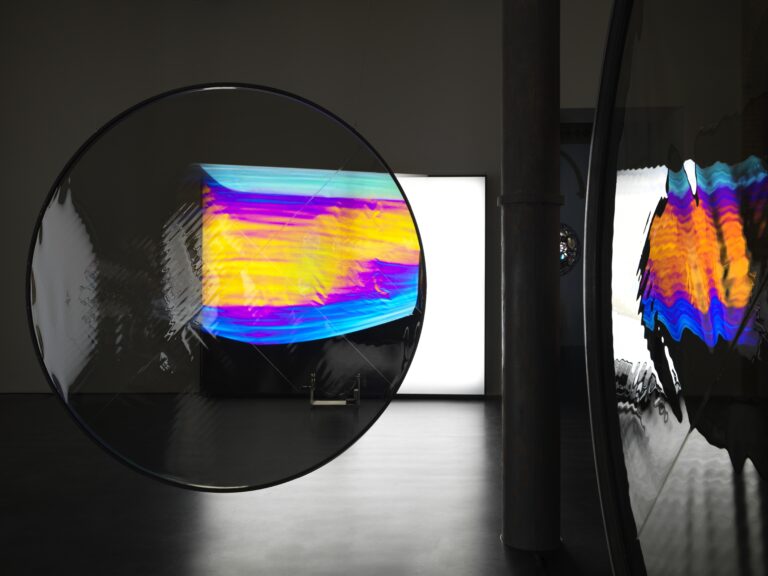
Olafur Eliasson, The lure of looking through a polarised window of opportunities, or seeing a surprise before it’s reduced, split, and then further reduced, installation view: neugerriemschneider, Berlin, 2025. Photo: Jens Ziehe. Courtesy the artist and neugerriemschneider, Berlin © 2025 Olafur Eliasson
Over the last three decades, Eliasson has examined our modes of seeing and encountering the world. The current exhibition extends this investigation with installations and complex geometric sculptures, using simple means to reveal the complexity of light and the contingency of what we see.
The artworks on display share a common set of materials and principles. They all explore polarization – optical filters that allow light waves of a specific orientation, or polarity, to pass through them while blocking all other waves. Polarization filters are commonly found in photography, where they are used to reduce lens flares. Eliasson reimagines this conventional function with his latest series of works, using these filters instead to create unexpected optical effects. A new installation resembles an experimental setup constructed from simple materials: spotlights, sheets of plastic and polarizing filters. Two spotlights shine through a polarized window into the gallery rooms. The light falls onto two rotating, equally polarized sculptural forms, producing vibrant colors that dissolve and reemerge. This phenomenon results from a quality of the material known as birefringence, in which the transparent surface splits light waves into rays that move at slightly different angles and speeds. The combination of the birefringent material and the two polarizing filters conjures multiple colors through an analytic process, whereby the white light is reduced, split, and then further reduced. As in much of the artist’s practice, the act of viewing takes on a dynamic, embodied dimension. While some elements of the artwork are in motion, it is primarily the viewers’ own movements and the changing angles of their bodies that activate the artwork. By moving around and assuming a different angle of view, they alter what they see. The works come to life through their engagement. Eliasson’s concept of polarization suggests a shift from rigid oppositions to a more fluid and inclusive perspective. By revealing the inner workings of perception, the exhibition challenges and reorganizes preconceived notions, turning these mechanisms into ways to reconsider our environment.
Olafur Eliasson (b. 1967) is currently the subject of a series of institutional solo exhibitions staged throughout Southeast Asia. Inaugurated at Singapore Art Museum in 2024, before traveling to Auckland Art Gallery and later that year, it will continue to Taipei Fine Arts Museum (2025); Museum of Modern and Contemporary Art in Nusantara, Jakarta (2025 – 2026); and Museum of Contemporary Art and Design, Manila (2026). The artist has also been the subject of solo exhibitions at international museums and institutions including The Museum of Contemporary Art, Los Angeles (2024); Istanbul Modern, Istanbul (2024); National Museum of Qatar, Doha (2023); Castello di Rivoli Museo d’Arte Contemporanea, Turin (2022); Fondazione Palazzo Strozzi, Florence (2022); Fondation Beyeler, Riehen/Basel (2021) ; Museum of Contemporary Art Tokyo, Tokyo (2020); Kunsthaus Zürich, Zurich (2020); Guggenheim Museum Bilbao, Bilbao (2020); Tate Modern, London (2019); Serralves, Porto (2019); Pinakothek der Moderne, Munich (2018); Red Brick Art Museum, Beijing (2018); Leeum Museum of Art, Seoul (2016); Château de Versailles, Versailles (2016); Moderna Museet, Stockholm (2015); Martin-Gropius-Bau, Berlin (2010); Museum of Modern Art and PS1 Contemporary Art Center, New York (2008); Tate Modern, London, (2003); Kunsthaus Bregenz, Bregenz (2001); and Kunsthalle Basel, Basel (1997). Eliasson lives and works in Copenhagen and Berlin.
For further press information and imagery, please contact Jonathan Friedrich Stockhorst: +49 30 288 77277 or jonathan@neugerriemschneider.com
advective motion, nebulous currents
With works by Ai Weiwei, Thomas Bayrle, Andreas Eriksson, Mario García Torres, Isa Genzken, Shilpa Gupta, Louise Lawler, Sharon Lockhart, Tobias Rehberger, Tomás Saraceno, Simon Starling, Pae White
3 MAY until 16 AUG 2025
Opening – 2 MAY 2025, 6-9 pm
At Linienstrasse 155, 10115 Berlin
The group exhibition advective motion, nebulous currents takes obfuscation as its focus, with narratives dissolved behind fog, distorted, streaked, rippled and pixelated in transformative actions, or softened to blurs. Here, in sculptures, photographs, prints and textiles, the rigidity of an articulated image dissipates and reality becomes malleable – undefinable and fleeting. As compositions meld in on themselves, perception reconfigures to scenes dreamlike and surreal, with afterimages, reverberations and ambient fluidity reflecting the ambiguities of modern existence.
ai weiwei Nord Stream, 2022
Ai Weiwei’s Nord Stream (2022) uses a photograph of the whirlpool resulting from a ruptured Nord Stream 2 natural-gas pipeline, taken by the Danish Ministry of Defense, as the base for its large-scale iteration in pixel-like Lego bricks, creating a link between the source and its wide-spread presence across digital media. Captured southeast of the Danish island of Bornholm on September 27, 2022, a day after the leak began, the aerial view encapsulates over two decades of heated international relations, and brings to mind the artist’s own career-long political involvement and activism. In using a seemingly playful, readily accessible medium, Ai leverages the colorful bricks’ approachability to draw attention to a critical moment, while employing their playful associations to give rise to tension between the material’s expected levity and the crucial, yet fragmented, scene on view.
thomas bayrle And Back Again – Helke II, 1991
Emerging in the 1960s from the visual languages of contemporary graphic design, advertising and mechanized weaving, Thomas Bayrle’s practice leveraged the mass-produced object and networks of infrastructure as tools for portraiture. Instrumental to this process was what he dubbed the Superform: A method of assembling series of repeated motifs to a larger image. In And Back Again – Helke II (1991), Bayrle presents a portrait of his wife, the Superform’s component parts here separated and flattened. No longer readily readable as a human likeness, the work takes on an abstraction rare for the artist, its optically rich patterning sending the gaze into a frenzy of misdirection.
andreas eriksson Lidköping No. 10, 2024
Employing a diverse archive of linens and silks, Andreas Eriksson’s Lidköping No. 10 (2024) builds upon the artist’s signature fields of color, translated to a hand-woven tapestry, augmented by organic, fringe-like inclusions. Threads emerge from the composition’s ground, draping over and sporadically masking its textured surface to cascade downward. They appear as if unraveled from their sources, yet upon closer inspection, are revealed to be intentional inclusions methodically ordered along an unseen grid, evolved from and expanding the principles of his painted works.
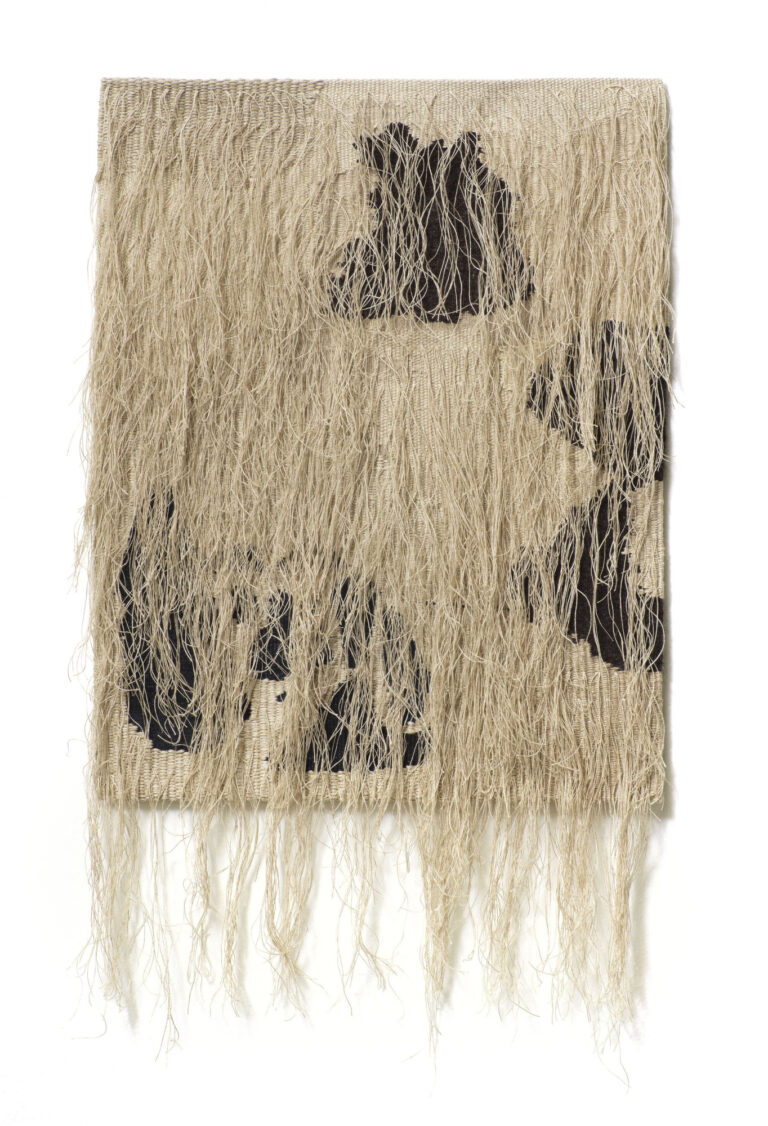
Andreas Eriksson, Lidköping No. 10, 2024
© Andreas Eriksson. Courtesy the artist and neugerriemschneider, Berlin.
Photo: Jens Ziehe, Berlin
linen, silk
77 x 46.5 cm
mario garcía torres When Stillness Produces Beautiful Moments, n.d.
Mario García Torres’ sculptural work When Stillness Produces Beautiful Moments (n.d.) is a poignant tribute to Alighiero Boetti – the Italian conceptualist to whom the artist has dedicated a number of crucial projects throughout his career. Here, García Torres takes as his point of departure Boetti’s Autoritratto (Mi Fuma Il Cervello) (1993 – 1994) – a self-portrait in which a bronze garden hose arcs water onto its head, where the stream meets heating elements and quickly turns to steam. García Torres’ work reduces Boetti’s selfportrait to just its hose, forming a monument to absence left in the wake of his outsized impact, and a testament to transformation and the vaporous nature of thought.
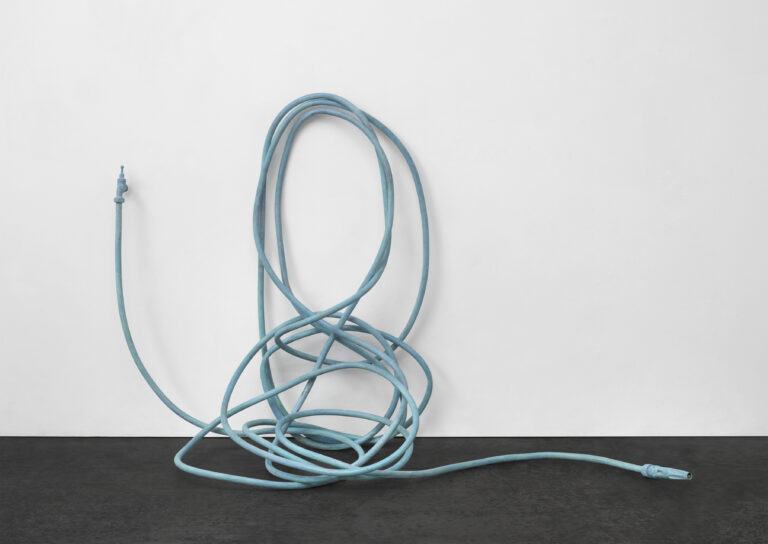
Mario García Torres,
When Stillness Produces Beautiful Moments, n.d.
bronze, copper
117 x 180 x 65 cm
© Mario García Torres. Courtesy the artist and neugerriemschneider, Berlin.
Photo: Jens Ziehe, Berlin
isa genzken Wolfgang, 1998
Isa Genzken’s Wolfgang (1998) is part of a series of sculptural works by the artist in which she assembles metallic and wooden panels to columns that tower above a viewer in approximations of contemporary architecture and its sleek glass exteriors. In Wolfgang, sterile mesh plates and warm-toned boards of fine-grained wood alternate as they ascend the monolith, revealing and concealing the structure’s barren interior in measured intervals. The layers of perforated material give rise to a moiré pattern that complicates the work’s strict structure, countering the principles of Modernism with contrasting, individualized modes of perception.
shilpa gupta Untitled, 2016
Plumes of dense smoke waft through the 12 panels of Shilpa Gupta’s photographic work Untitled (2016), where curled apparitions take on shapes indefinite and infinite, dodging focus as they emerge from the edges of each composition. As much of Gupta’s work, Untitled too addresses the paradox of definitions, in particular the arbitrary nature of borders and the methods with which they are often drawn and enforced. Evocative of clouds, the pictured smoke is granted free passage into the domestic, its very presence the deconstruction of traditional divides.
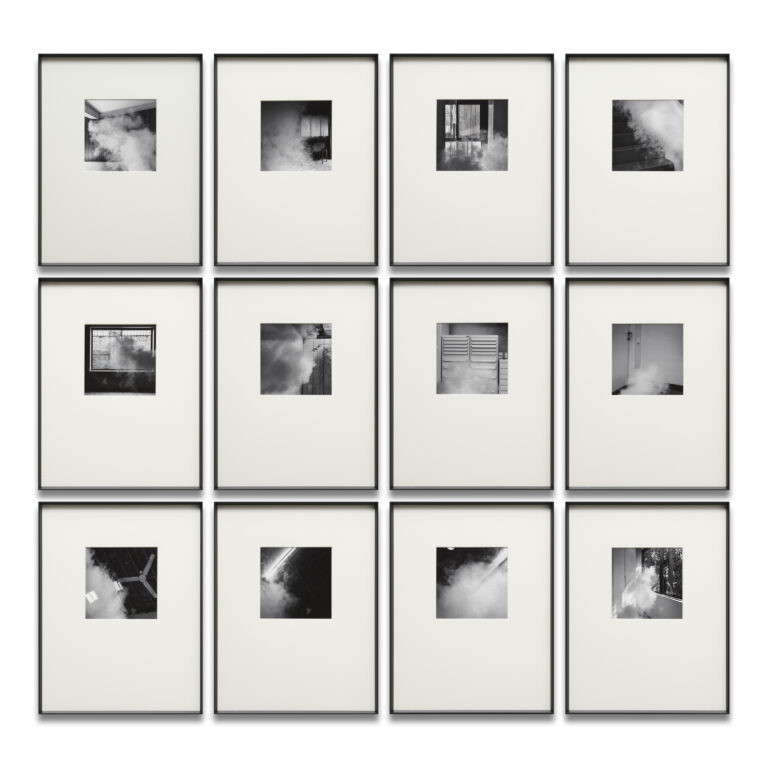
Shilpa Gupta,
Untitled, 2016
digital photograph printed on Photo Rag paper
12 parts: 43 x 33 cm each
© Shilpa Gupta. Courtesy the artist and neugerriemschneider, Berlin.
Photo: Jens Ziehe, Berlin
louise lawler What Is Painting (swiped), 2022/2023
Louise Lawler’s What Is Painting (swiped) (2022/2023) – part of a series of photographs distorted by her moving camera and its open shutter – sees the bright canvas and dark lettering of John Baldessari’s What Is Painting? (1966 – 1968) blur as if in dynamic motion. Spatially shifted, or “swiped,” Lawler’s action enters into conversation with Baldessari’s. She counters the painting’s semi-ironic message through layers of appropriation and reinterpretation, and in turn, interrogates the conditions of authorship, institutional display and canonization.
sharon lockhart Untitled, 2023
A mid-winter landscape as it rises gently before the camera, obscuring the approach to the sea that sits behind it, features in Sharon Lockhart’s Untitled (2023). Tall grasses, rendered pale by the season’s set-in chill, are coated in airy layers of falling snow. Fog looms, creating a nearly empty sky – the image’s intricately textured lower segment starkly contrasts the void that lies above it, masking the world that presumably lies beyond. Here, Lockhart re-engages with the seascapes and shorelines that have pervaded her practice for the past decades in a musing on a relentless, life-sustaining, yet unknowable force.
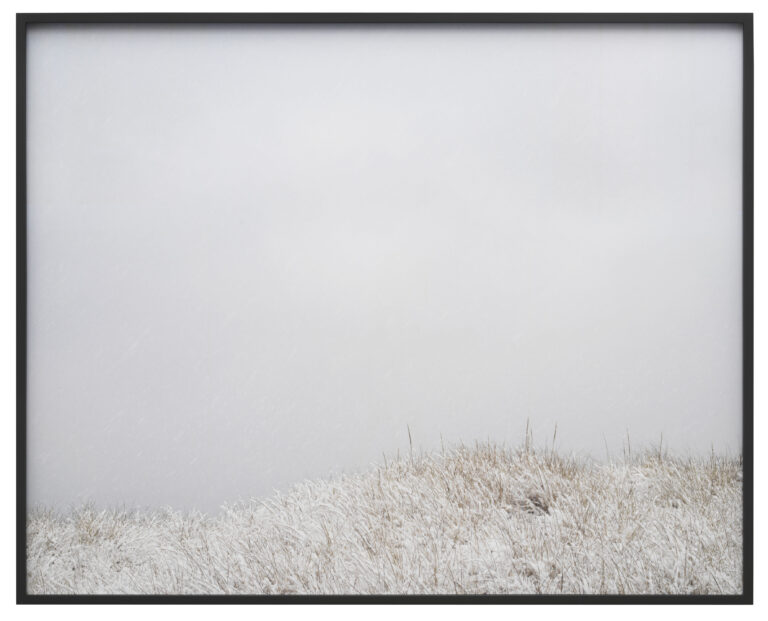
Sharon Lockhart,
Untitled, 2023
framed chromogenic print
83.3 x 104 cm
© Sharon Lockhart. Courtesy the artist and neugerriemschneider, Berlin.
Photo: Jens Ziehe, Berlin
tobias rehberger Utagawa Kunisada Shiko no nagame 1829 I, 2015
The vibrantly colored mural in Tobias Rehberger’s Utagawa Kunisada Shiko no nagame 1829 I (2015) sees a pixelated image, coded and imperceptible until viewed from a distance or reduced to fit a screen. Only then do the oversized, square-shaped modules merge to an facsimile of an erotic Japanese shunga woodcut. This print sits behind a vase that, clad in this same motif, seemingly disappears against its background, camouflaging itself while remaining in plain sight, thus allowing Rehberger to interrogate how context informs object’s impact and allows it to transform.
tomás saraceno Wayra 246, 2025
Tomás Saraceno’s Wayra 246 (2025), a sculptural network of solid-glass polyhedrons composed to cloud-like clusters of interconnected modules, appear to exist at the intersection of air, water and earth. The work’s suspended structures intertwine and seem to physically support one another through their shared facets, prompting questions on notions of space, order and symbiosis. Here, Saraceno juxtaposes the static nature of sculptural forms and the organic movement of natural systems, while the faces’ enigmatic transparency hints at the fluidity of boundaries and the interdependence of systems and their surroundings.
simon starling Pin Board Painting, 2021
In the meticulously constructed, two-part installation Pin Board Painting (2021), Simon Starling takes as a point of departure an early 20th-century installation view from what was then the Berliner Nationalgalerie in Berlin (today the Alte Nationalgalerie), recreating this once-miniscule catalog reproduction in magnified form using black push-pins. The countless pins are precisely clustered such that their round heads emulate an offset print’s method of rendering an image. Re-photographed and shrunk back to the image’s initial dimensions as discovered in its source, the inserted push-pins begin to visually coalesce, forming what appears as the original installation photograph, and in turn crafting a commentary on the subjectivity of the image.
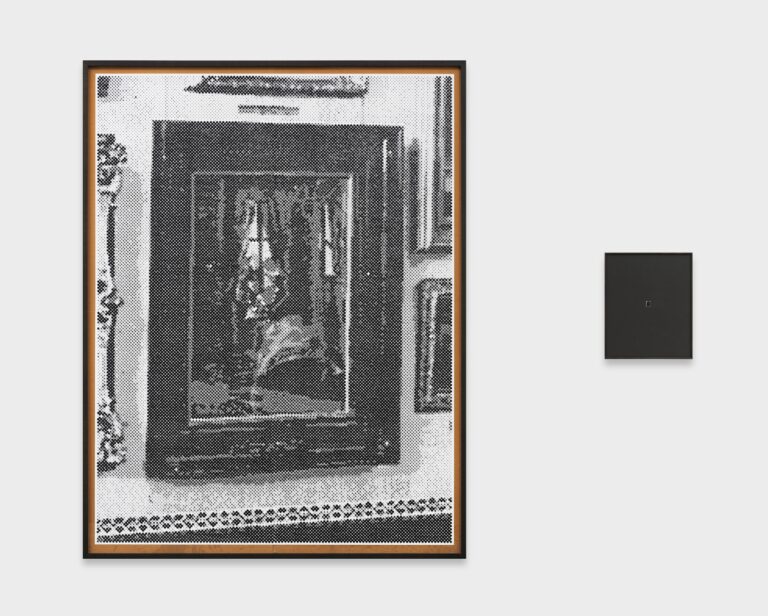
Simon Starling,
Pin Board Painting, 2021
left: 75:1 Scale Reproduction of a Detail of an Installation View of Adolph Menzel’s The Artist’s Bedroom, 1847; push-pins, softboard,
paper, wood; 242.2 x 187.2 x 9.5 cm
right: 75:1 Scale Reproduction of a Detail of an Installation View of Adolph Menzel, The Artist’s
Bedroom, 1847 (Re-photographed and Returned to its Original Printed Size); silver gelatin contact print; 57.3 x 47.3 x 3.8 cm
© Simon Starling. Courtesy the artist and neugerriemschneider, Berlin.
Photo: Jens Ziehe, Berlin
With her tapestry Noisy Calm, November (2025), Pae White returns to the elaborate process of translating the ephemeral to woven materials, paying tribute to the natural world’s splendor. To reinterpret the tradition-rich, labor-intensive, enduring technique of weaving, she fabricates a digital image using an industrial Jacquard loom in a clash of media and theme. Here, threads of cotton and polyester capture the elusive by way of a lakefront landscape. Softened behind low-lying mist, the articulated image begins to dissolve, suspended between representation and abstraction, inscrutable and barely tangible.

